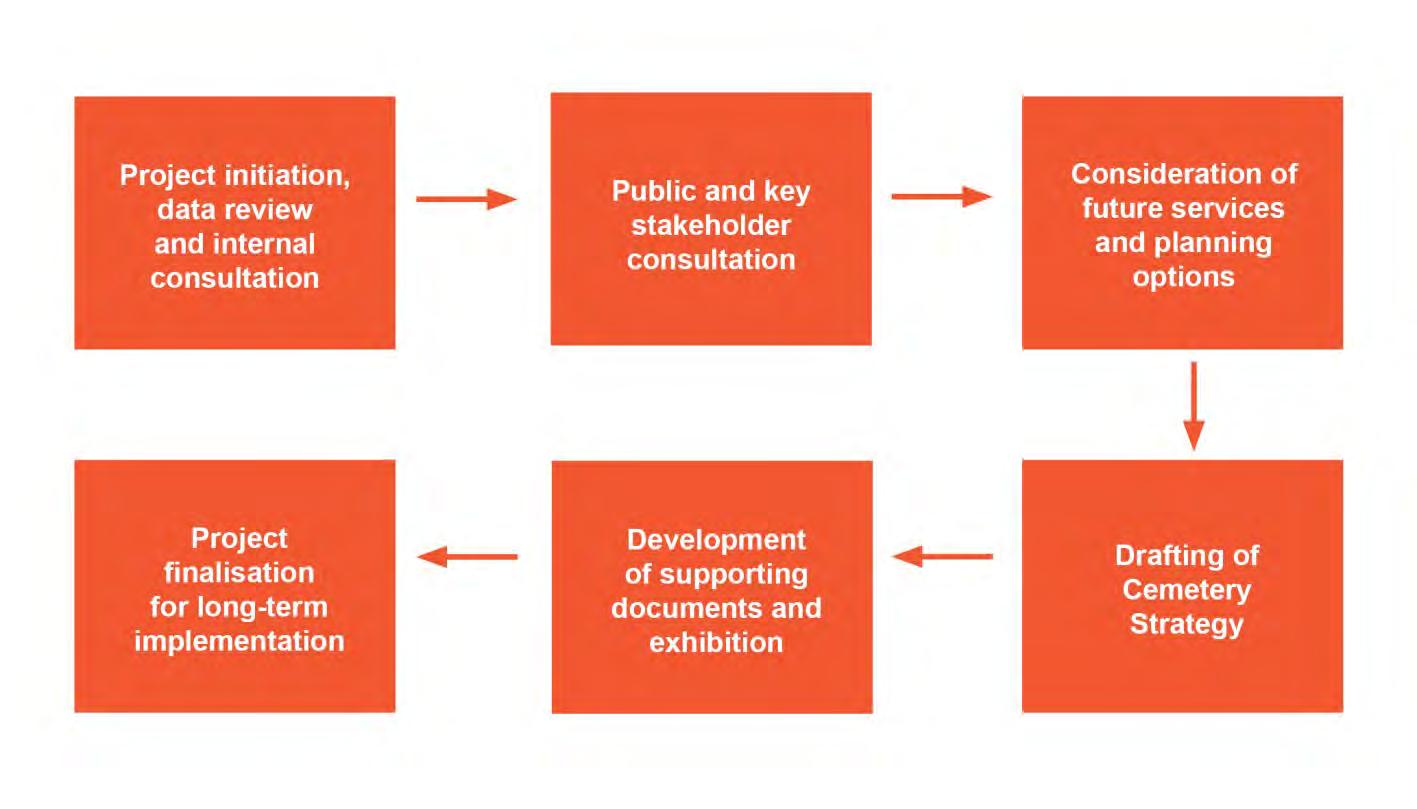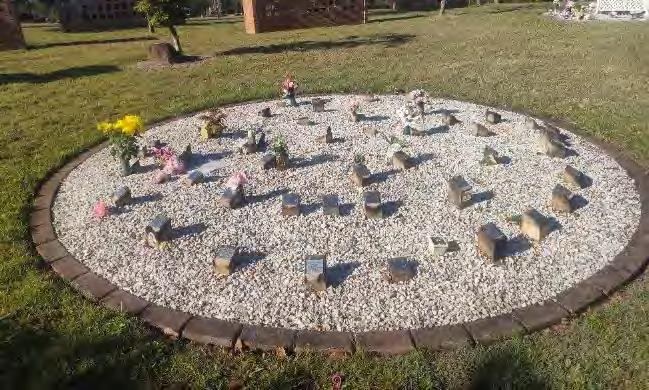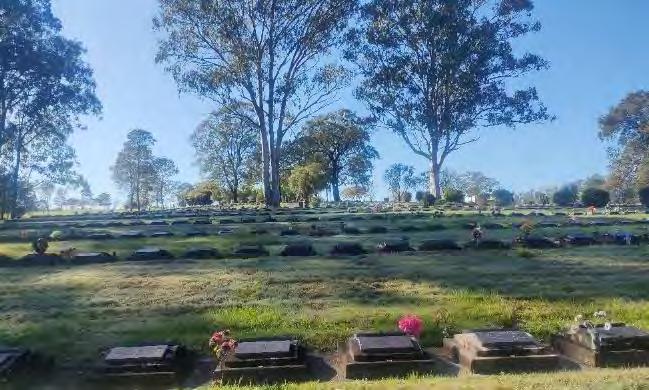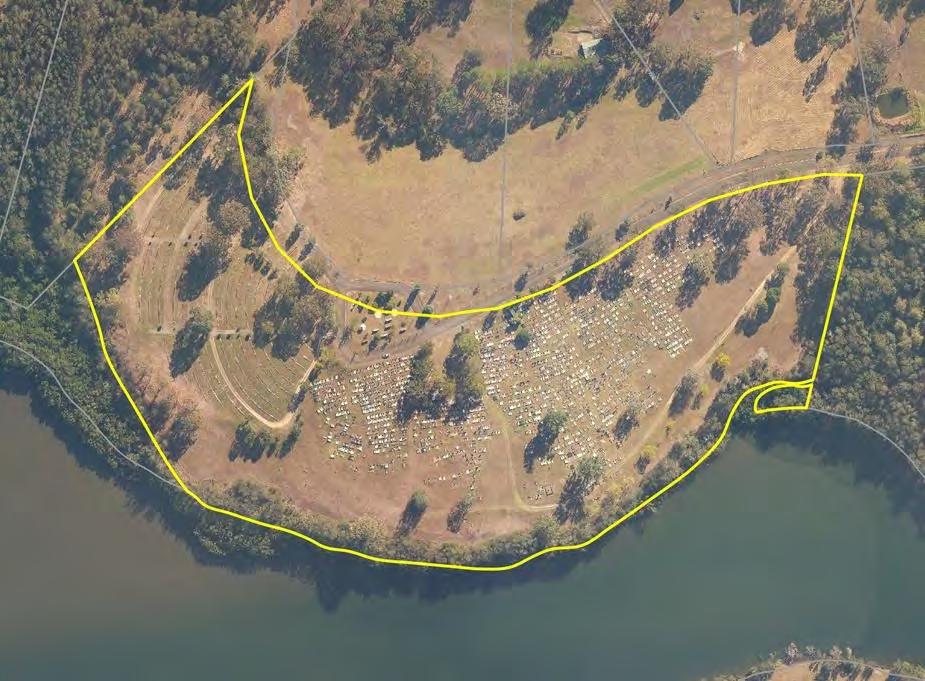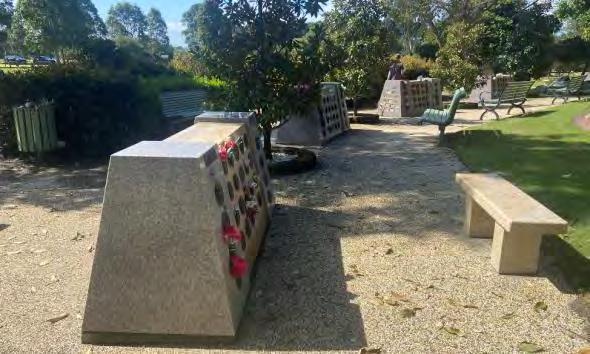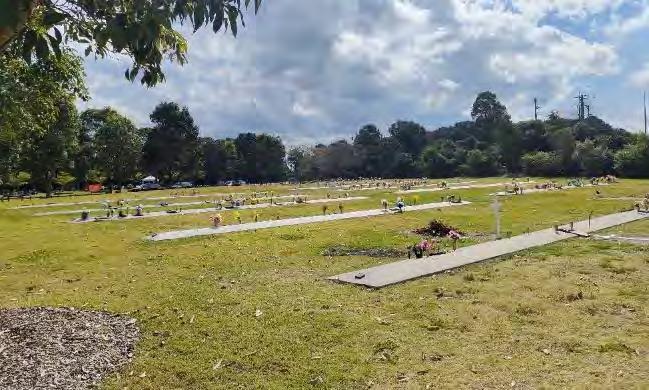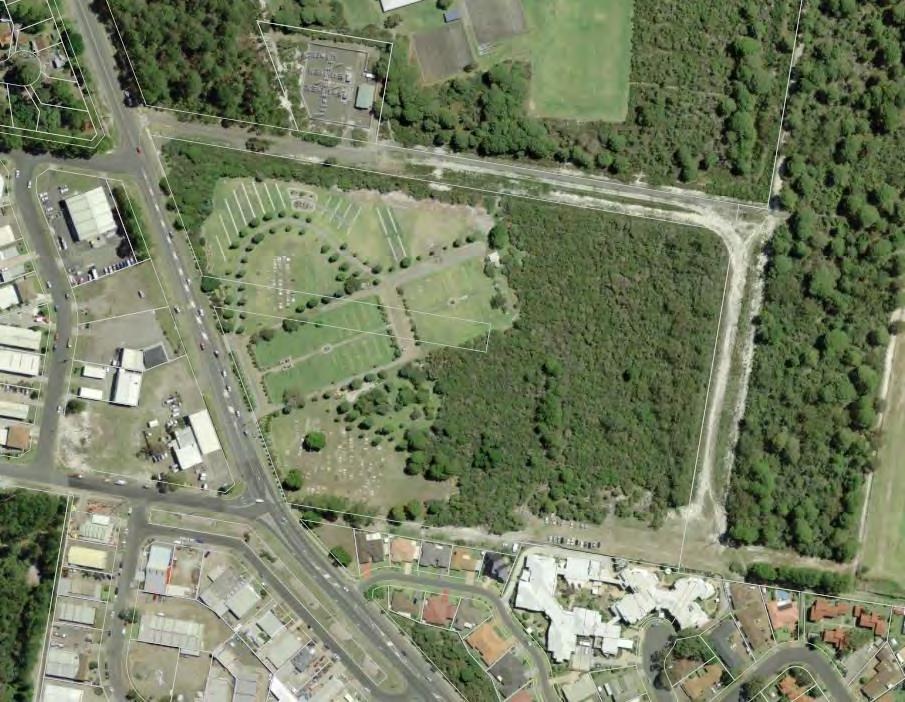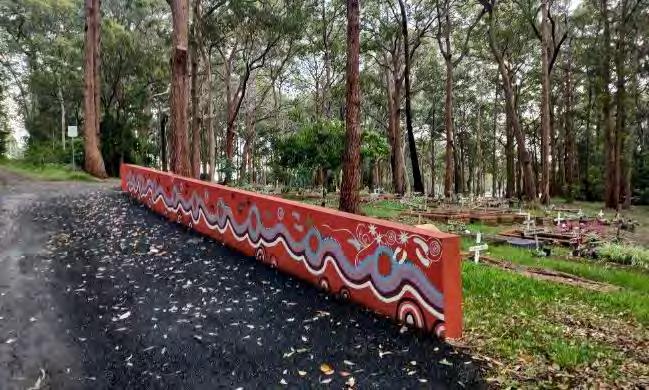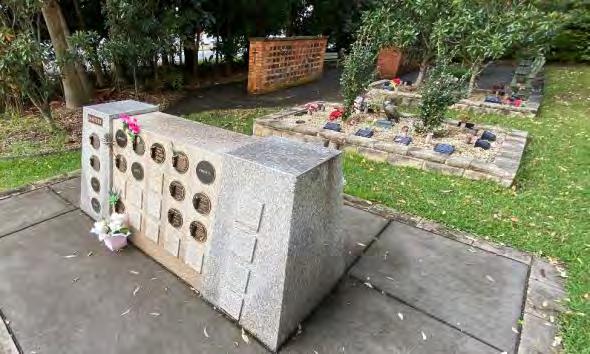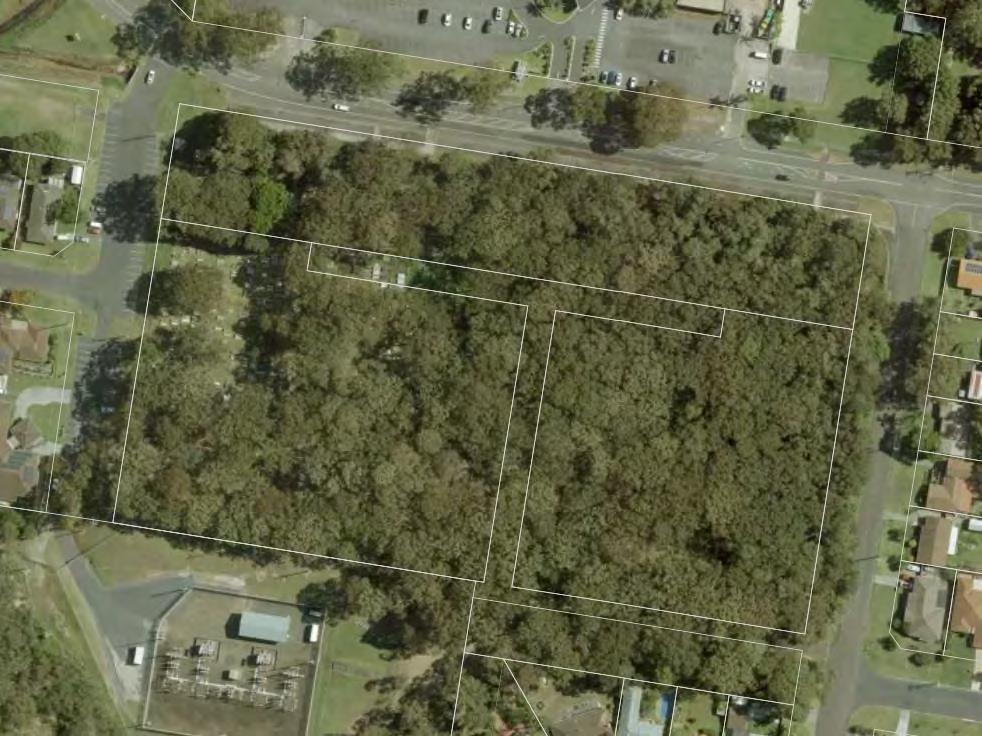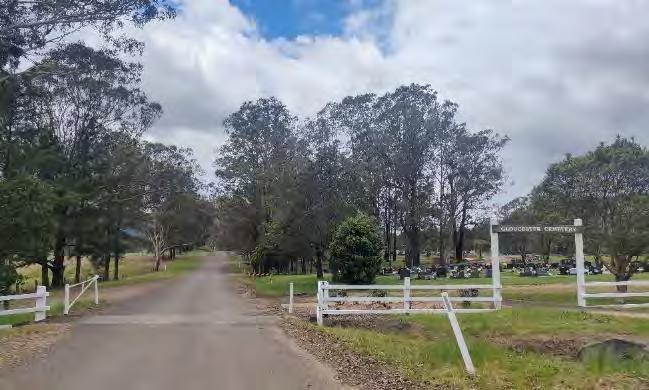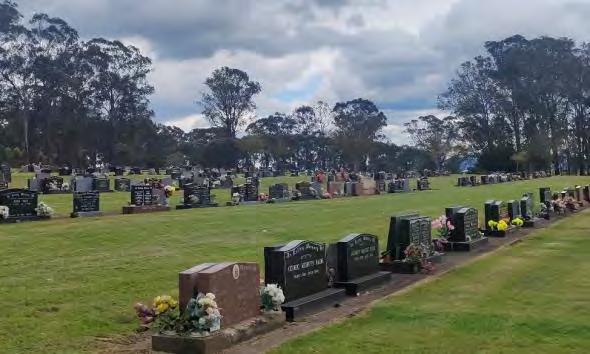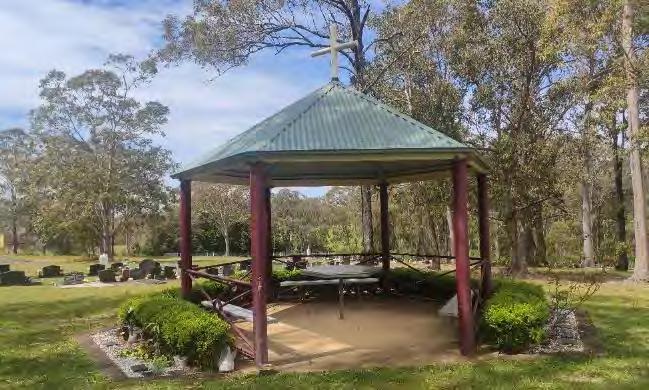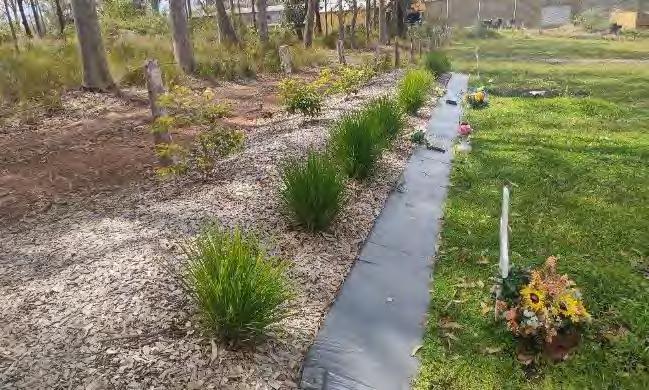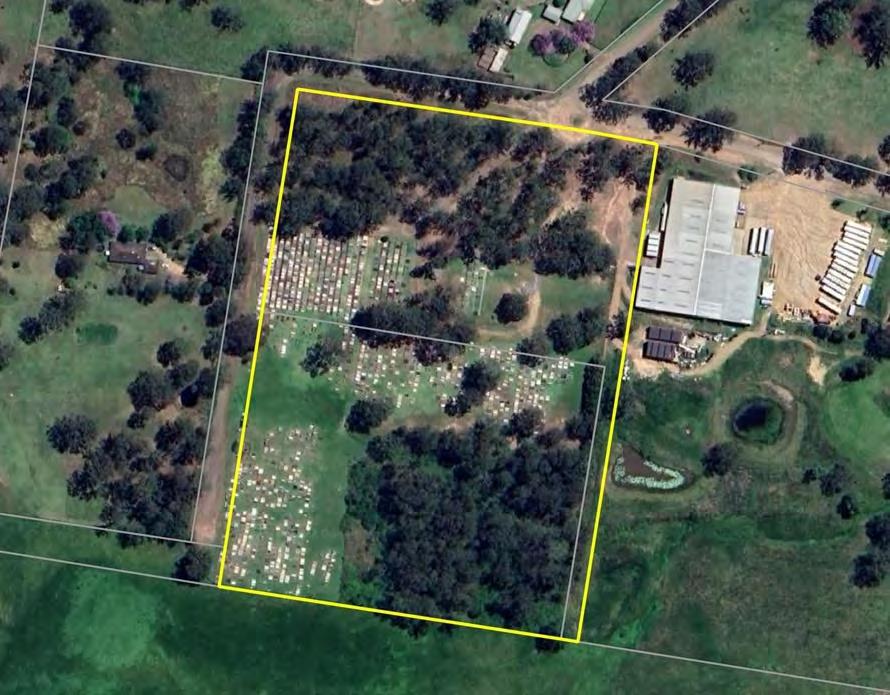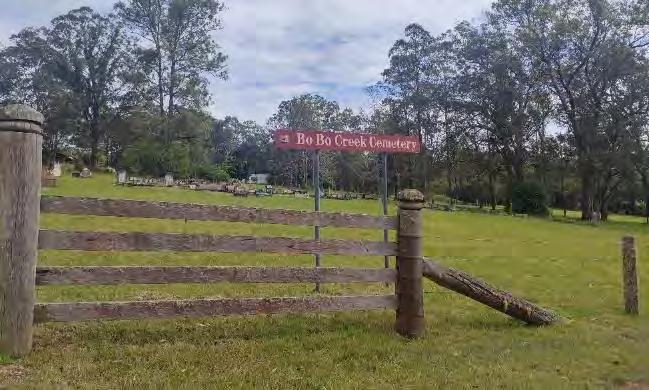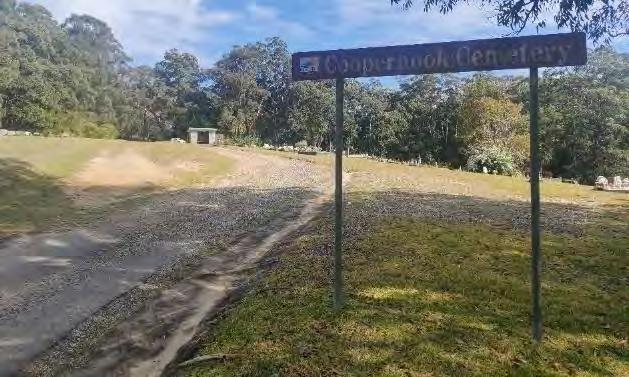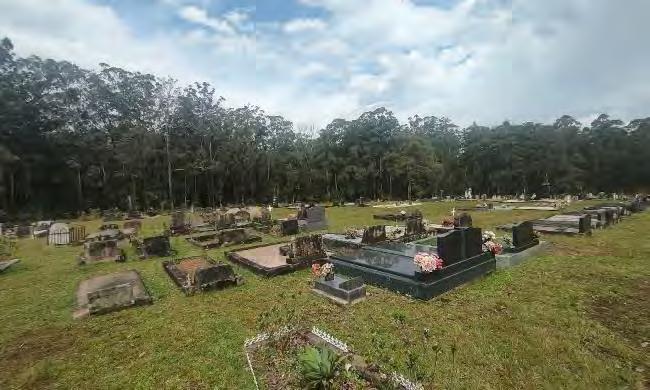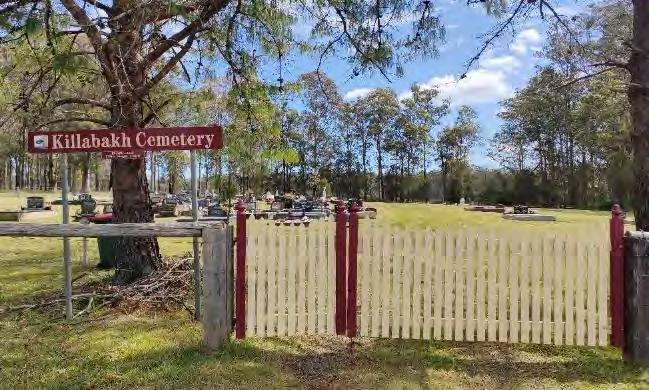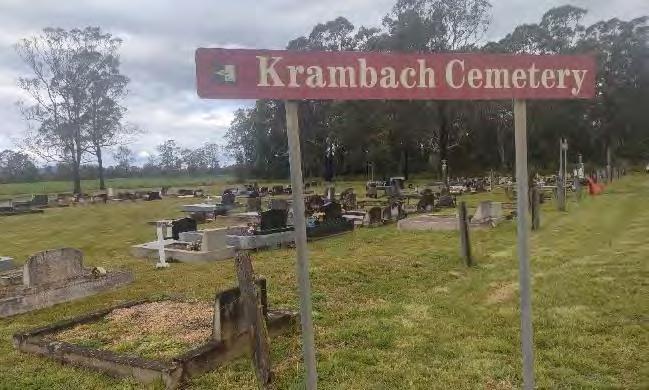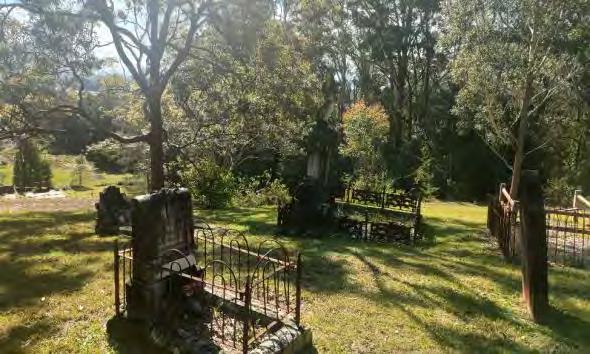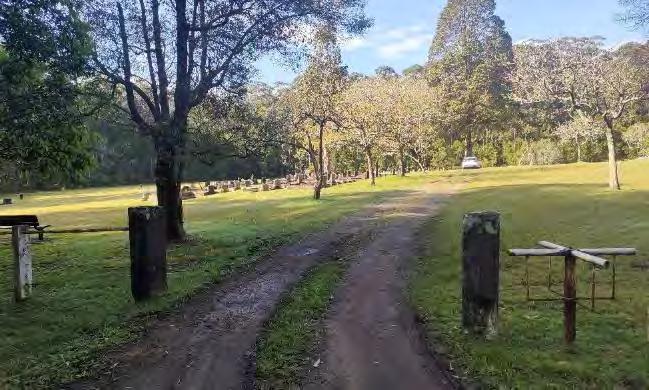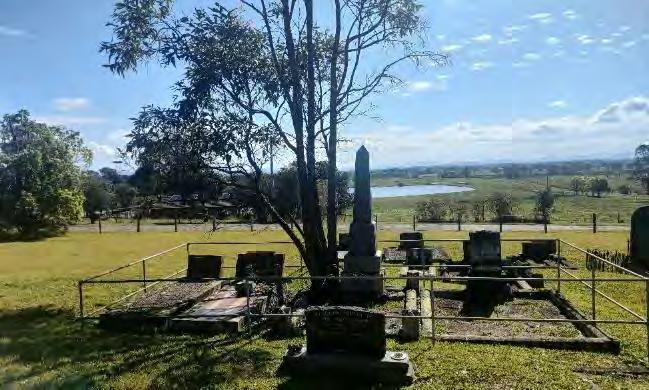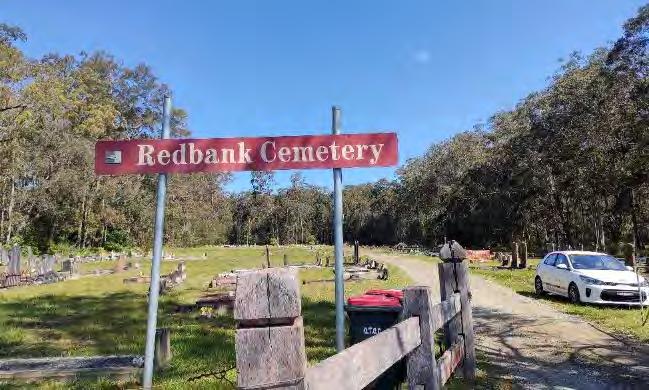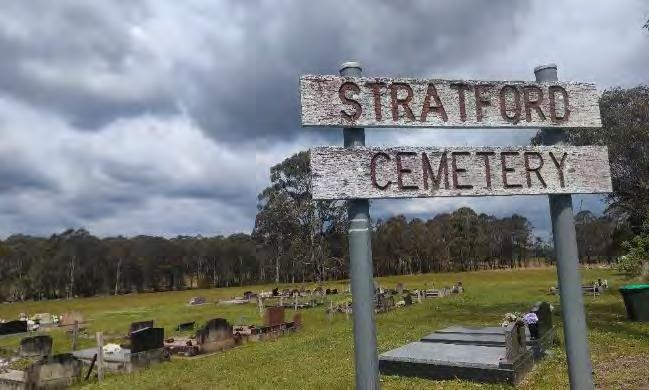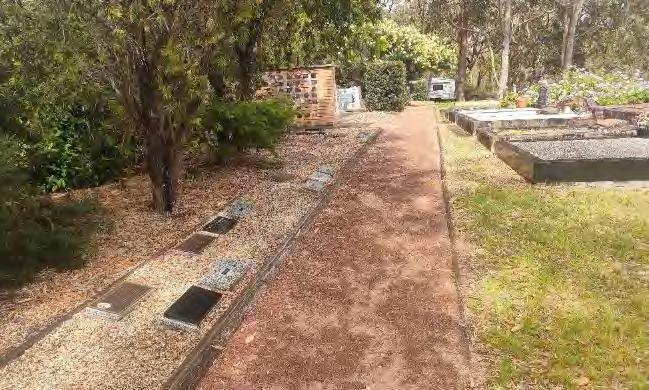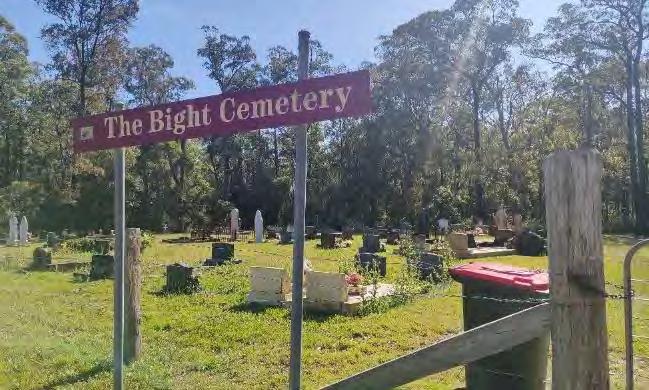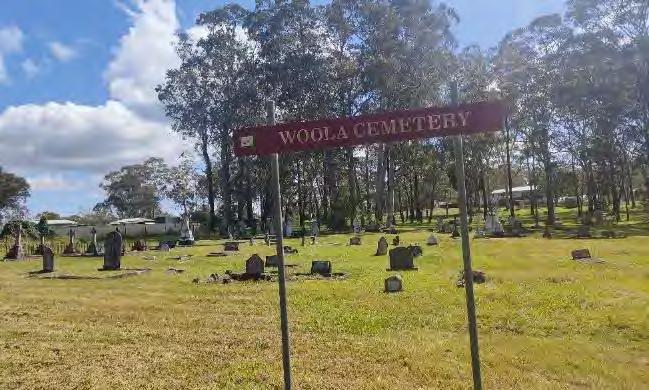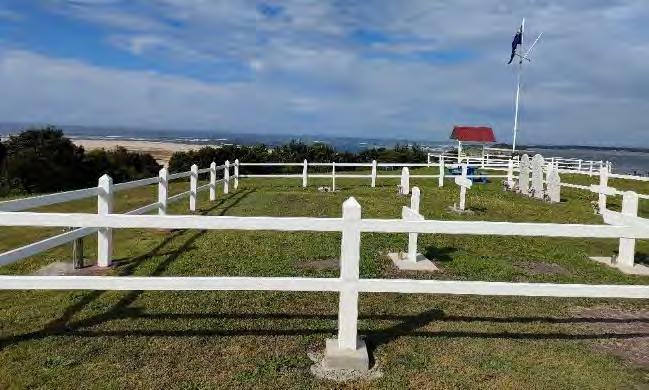Financial performance of the service
Financial results of cemetery services are generally closely aligned with number of deaths and number of resulting interments that occur over a given period. This is particularly true in terms of revenue, which can change significantly from year to year with changes in burial and reservation demand. Costs may also be borne by cemeteries from year to year in terms of pre-emptive capital works (eg ash walls, lawn beams etc).
With recent changes to fees and charges resulting from equalisation of previous Council arrangements, the service is now in a more financially sustainable position to address future challenges. This includes the effort required to align the differing approaches of the former LGAs, as well as implementation and ongoing delivery of the new Interment Industry Scheme
In a broader sense, current fees and charges are reasonably well aligned to outcomes of IPART’s recent NSW wide investigations into interment costs and pricing3, albeit the timing of collecting fees may need to be adjusted in accordance with the incoming Interment Industry Scheme Opportunities also exist to increase fees and charges in the future to best meet a cost recovery model once a more detailed tracking of revenues and costs are established
Demographic trends and implications
Population changes, death rates and religious beliefs and their trends have a strong relationship to the level of service and infrastructure provision of Council’s future cemetery facilities. Key trends of note include:
A growing area, with population increase by 18% by 2036
A slowly declining death rate at 6 deaths per 1,000 population per annum in 2020
Number of deaths to increase by around 50% to 2036 based on projected population growth and ageing population
2021 census results highlight that MidCoast resident place of birth was predominantly Australia at 82%, compared to only 56.8% in Greater Sydney. With respect to religious affiliation, the MidCoast population is largely Christian (72.4%), with Anglican (33%) and Catholic (20%) being the predominant branches. No religion and the “affiliation not stated” categories totalled 26.3% of respondents, whilst no other religious groups totalling around 1% of the total population. Notably, there is a comparatively small number of Jewish (0.05%) and Islamic (0.13%) people represented in the community, being faith groups that have a very strong preference for burial practices and traditions
3 See https://www.ipart.nsw.gov.au/Home/Industries/Special-Reviews/Reviews/Cemeteries/Interment-costs-and-pricing-in-NSW
MidCoast Council Cemeteries Strategy Page 8
ID Forecast Population and ABS Deaths, Australia, 2020
ID Forecast Population and household forecasts household forecasts forecast.id.com.au/midcoast forecast.id.com.au/midcoast
Cemetery trends
As previously identified, cemeteries in NSW are operated by a range of organisations In more recent times, the private sector has become much more involved within the cemetery industry in NSW. This is particularly evident through listed companies such as InvoCare and Propel Funeral Partners, but also through smaller operators such as local funeral directors who operate crematoriums, memorial gardens and sometimes, cemeteries. Over time this has seen a shift in some regions where councils were previously the sole or main cemetery operator. For example, in the MidCoast Council area, there were around 330 interments in Council operated cemeteries in 2016/2017, representing around 30% of the market at that time. Our estimates suggest that by 2021/2022, this rate has reduced to around 25%, likely to reflect this increasing competition.
However, the emergence of private cemeteries is not the only notable trend. Rates of cremation have also steadily increased over recent generations, with some regions now having a cremation rate of more than 80% - including within the North Coast Region that includes the MidCoast LGA.
At the broader NSW level, there is known to be a cemetery burial supply shortage / concerns in the Sydney metropolitan area. This, in part, has resulted in statewide actions, including a cost and pricing review of the industry by IPART, and a review of the Cemeteries and Crematoria Act 2013, both being completed in 20204
In the MidCoast LGA context, there remains significant supply available across the cemetery network, albeit some cemeteries, such as Dawson River, Forster and Tea Gardens, require actions to be taken in the short-term to facilitate necessary changes to ensure longer-term provision of their ongoing service to local communities. This includes:
• Ensuring approvals are in place for expansion where possible
• Maximising available space for burial and memorialisation activities
• Creating long-term plans for memorialisation so that cemeteries can continue to be utilised once burial space is at capacity
• Establishing policy measures to ensure all available plots are maximised, and
• Undertaking further plot identification through ground penetrating radar to facilitate infill opportunities where necessary.
Existing situation summary
While not legislatively mandated, Council has a clear and necessary role in the provision of cemetery services. The LGA has a growing and aging population, meaning that the number of deaths is expected to increase by more than 50% by 2036. While some of this growth is likely to be taken up by increasing cremation or cemetery burial competition, there is also likely to remain a portion of the population that have a preference for interment within their local cemetery, meaning that demand could also steadily increase over time at Council’s cemeteries. From this perspective, Council’s long-term position with respect to burial services, and spread of cemeteries across the LGA are key strengths.
4 See https://www.ipart.nsw.gov.au/Home/Industries/Special-Reviews/Reviews/Cemeteries/Interment-costs-and-pricing-in-NSW and https://www.cemeteries.nsw.gov.au/about-us/review-nsw-cemeteries-and-crematoria-act respectively.
MidCoast Council Cemeteries Strategy Page 9
With respect to religious and special service requirements, Council has the capacity to service particular need groups on an as needs basis. Based on the existing demographics and associated trends, there is unlikely to be any significant changes in demands for special services over the short or medium term, albeit Council may need to respond as necessary should such requests be made and in accordance with Interment Industry Scheme licencing requirements.
On the service performance side, there would however appear to be some improvements that can be made, particularly resulting from the amalgamation of former councils and the resulting differences in previous approaches. These improvements include:
• Establishing maintenance and management approaches and guidelines that respond to localised needs, whilst creating greater consistency between the former regions;
• Working towards a consistent online platform for both internal and external enquiries, including ensuring that recording keeping is improved for reporting purposes; and
• Improving the consistent capture and reporting of financial information to better understand community preferences, true cost of services and to improve the financial sustainability of the service.
With the IPART review of interment pricing now complete, and the introduction of an Interment Industry Scheme being undertaken for the first time, there may also be significant changes in the way cemetery services are regulated and priced in coming years.
Overall, and after several difficult years of service integration resulting from amalgamation, the scale of the service and improving financial position highlights opportunities to continue to build a successful service to meet ongoing community needs. While increasing regulation is likely to continue to raise challenges moving forward, it also brings with it clearer expectations and benchmarks that can assist Council to improve its operations, respond to community needs and work towards a cost recovery position.
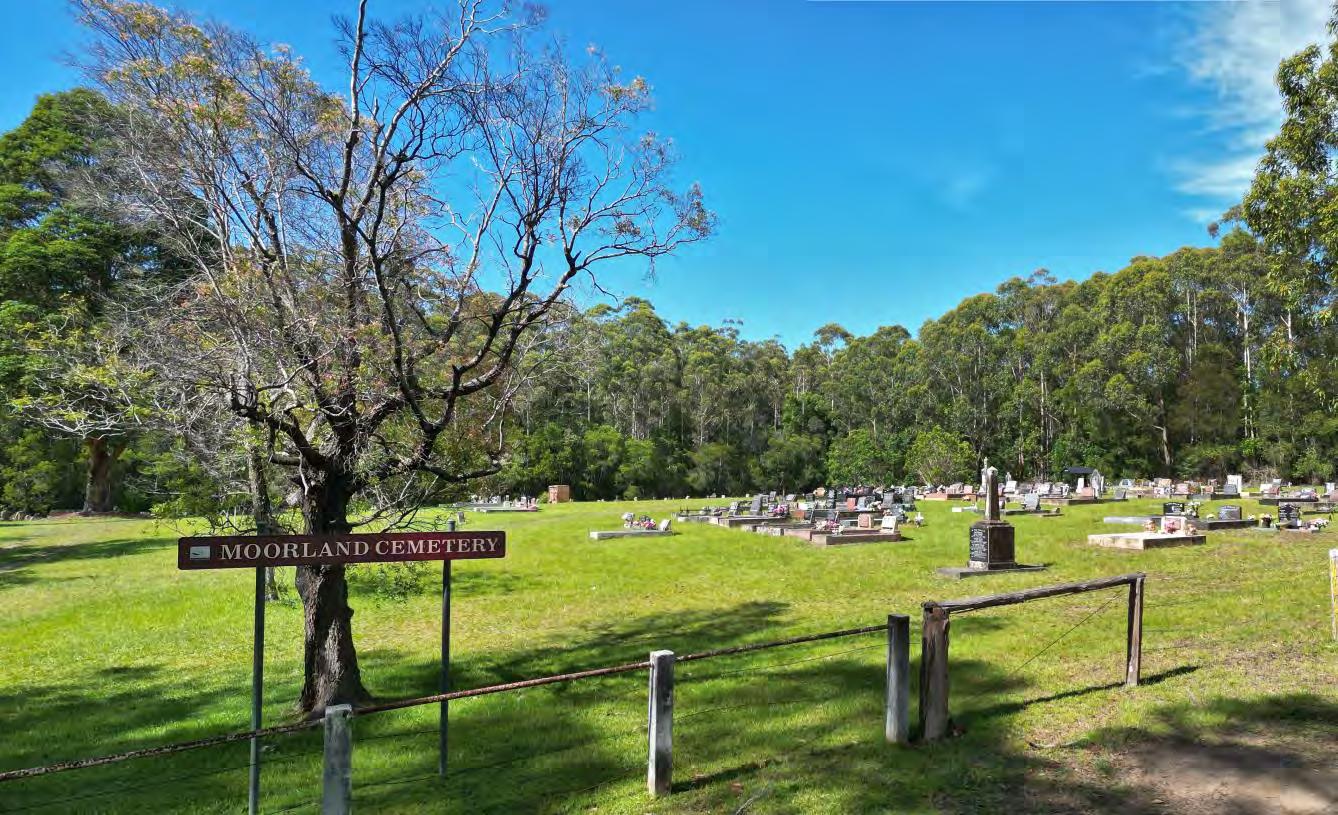
MidCoast Council Cemeteries Strategy Page 10
Moorland Cemetery
3. What we heard
In developing this Strategy, engagement with the general community and those stakeholders that are associated with Council’s cemeteries and services was undertaken. This included consultation with:
• Local funeral directors
• Aboriginal groups
• Heritage group representatives
• National Trust
• Blight of the Bight group representatives
• Contractors such as those undertaking grave digging
Broader public consultation was also undertaken via an online survey, with more than 100 responses received.
Key themes that were apparent through the consultation process were:

Concern over the lack of information, including online, within registers and on-site, to assist in accessing cemeteries and undertaking family research / genealogy tasks

General feeling of pride in local cemeteries, including many being complimentary about maintenance and good availability of cemeteries.

Desire for cemeteries to retain their character, particular aspects of rural vistas and natural settings

High importance of Redbank Cemetery and Forster Cemetery, particularly the Aboriginal burial portions, as well as a number of other cemeteries that have close connection Aboriginal communities

Desire for acknowledging and celebrating heritage and historical aspects of cemeteries, including collaboration with heritage groups

Concerns about the upkeep of specific infrastructure, such as roads and signage, as well as memorials, even though these are not the responsibility of Council

Concerns over previous activities at the Bight Cemetery in particular, as well as concerns regarding cemetery upkeep more broadly, with specific examples often being identified

Desire for natural burial opportunities to be made available, and for cemeteries to be respected from their environmental values more broadly.

That Council take on, care for or provide interment at cemeteries that they are not the current operators of. These include cemeteries such as Carrington Cemetery, Gilwarra Cemetery, Neranie Head Cemetery, Boolambayte (Sunnyside) Cemetery, Tobwabba Cemetery Hill and Purfleet Cemetery
MidCoast Council Cemeteries Strategy Page 11
Survey respondents identified that whilst cost was an important factor, having a naturally beautiful environment, an appealing and comfortable place for friends and family to visit, and having minimal impact on the environment were all more important across respondent feedback.
In terms of Council’s services, maintaining cemeteries to a high standard, preserving areas of high environmental importance and providing for ‘natural’ or ‘green’ burial options and options for ashes interments were considered to be of most importance.
The ongoing challenge identified by some was how to maintain a vast array of cemeteries and related services in an affordable way. This is of course a key balance to be struck for Council to avoid high fees or significant subsidies being required.
The following key consultation principles, combined with the outcomes of the existing situation in the previous section, have provided a basis for the development of directions for this Strategy
1 Environmental assets
Be considerate of natural assets and environmental outcomes
3
Heritage and history
Document and celebrate heritage and historical opportunities
5
Consistency
Create and implement consistent policies and procedures
2
Respect and care
Respect and care for facilities and infrastructure
4
Accessible documentation
Establish more accurate and accessible interment listings
6
Cultural understanding
Recognise and respect Aboriginal and other cultural needs
MidCoast Council Cemeteries Strategy Page 12
4. Future directions
The future directions identified in this section are designed to create both efficient operations to maximise value for the community whilst being responsive to consultation outcomes and broader industry trends. Directions are also carefully considered in the context of the changing regulatory environment, with the introduction of the State Government’s Interment Industry Scheme having now commenced and to be rolled-out in coming months and years. Together, these directions are designed to create a service which is able to operate on a cost recovery basis, is well-connected to community needs, and is compliant with regulatory standards.
In broad terms, and recognising the large number and significant ongoing maintenance cost of cemeteries managed by Council, the long-term directions of Council can only be achieved by:
• maximising the use and efficiency of existing facilities through consistent application of processes to ensure their operational longevity, including for both burial and memorialisation purposes, and
• creating efficient and effective administration processes to enable an increase in the delivery of community connections through information availability, marketing and product delivery that responds to community needs.
Future directions have been identified through a timeframe to 2036. Directions have been identified across four areas as follows:
Governance and management
relating to how the service is structured and manages its affairs
Infrastructure, maintenance and facility provision relating to the physical on-the-ground infrastructure and facilities, and how these are to be maintained
Service development relating to opportunities for developing the service into a more customer-focused entity with a view to creating a suitable level of long-term financial sustainability
External trends
relating to the external issues and trends that may have an impact on, but are not in the control of, Council’s cemetery services
Recommendations that are of high priority for short-term action are identified with the following icon:
MidCoast Council Cemeteries Strategy Page 13
Governance and management
Overarching governance and management of public cemeteries is critical to ensuring effective financial management and continued community support for cemetery services Recent IPART and legislative reviews, and the subsequent introduction of the Interment Industry Scheme reflects this increasing regulation and ‘professionalising’ of the industry. This means that cemeteries should no longer be considered as a minor community service obligation.
Key to this will be establishing and implementing consistent processes and standards across Council’s network of cemeteries. Once processes and standards are in place, including more consistent financial records and online records systems, there is an opportunity to then examine more detailed aspects of the service, including increases to the pricing of interment services to meet cost recovery.
Fee structures and pricing
Council sets its pricing as part of its annual fees and charges. Pricing and the structure of fees to provide services has been compared with others locally, regional best practice leaders such as Shoalhaven City Council, those in Sydney and via recent benchmarking undertaken by IPART. This benchmarking highlights:
• Overall costs for lawn burial are at the low end of IPART’s identified efficient costs (around $4,000 - $5,000), and slightly below Port Macquarie-Hastings Council. Fees are significantly lower than those charged in Sydney and below regional leaders such as Shoalhaven City Council.
• MidCoast Council has a very low plot reservation / licencing fee, with the interment fee carrying the bulk of costs. This is contrary to IPART review recommendations which suggest the bulk of costs being associated with the plot licence (including maintenance), with interment cost being largely associated with digging costs and associated administration.
• Memorialisation fees for columbarium walls are relatively consistent with the wide variety of the market, but garden memorials are relatively low, perhaps reflecting the relative quality of offerings.
Recommendations
1 Cemetery pricing be reviewed to correlate with “burial” and “burial right” definitions of IPART, bringing forward the ongoing site costs (eg maintenance) to the point of reservation rather than at the point of physical burial.
2 Fee increases be considered over time to reflect actual costs (cost-recovery), including a perpetual maintenance fee that becomes reserved for long-term maintenance needs.
3 Memorialisation opportunities be based around a three-tier pricing system – ‘good, better, best’ - and that products be developed and promoted to achieve this.
4 Council note the current reforms towards an ‘Interment Industry Scheme’ and incorporate relevant recommendations into future pricing as required
MidCoast Council Cemeteries Strategy Page 14
Cemetery capacity
While the ultimate capacity of a cemetery is subject to many considerations and the uptake of burial sites can change rapidly in comparison to the life of the cemetery, understanding the remaining capacity is important to inform future site and/or staffing activities. Overall, there is longterm capacity available across Council’s portfolio of cemeteries. There are however points of supply concern within some cemeteries as follows.
• Forster and Tea Gardens Cemeteries: Forster Cemetery is both land-locked and likely to be highly valued within the community for its vegetated appearance within an otherwise urban setting. Unless Council is prepared to remove substantial tree cover5, there is likely to be limited burial capacity within the cemetery over the long-term, with Council’s calculations indicating 11 – 15 years’ capacity. Similarly, Tea Gardens Cemetery is a small and well utilised cemetery, again being land locked between urban neighbours to the north, east and west, and mapped coastal wetlands to the south. Whilst some space remains, Council’s calculations indicate this this will only comprise 16 – 20 years’ capacity.
Given these circumstances, it is recommended that these cemeteries continue to develop memorialisation offerings to enable the ongoing use of the cemetery beyond the projected burial capacity, including the preparation of long-term plans to provide direction to future allocations of space and associated layout. At the same time, a number of actions can be taken to prolong the availability of burial space. This includes:
– Restricting future reservations and withholding remaining plots for use at need
– Reviewing existing reservation over 50 years of age that have not been utilised, and if viable, commence a process of reclamation of these burial rights for resale
– Undertaking additional investigations (eg ground penetrating radar), to determine if any additional plots can be identified and released for future use
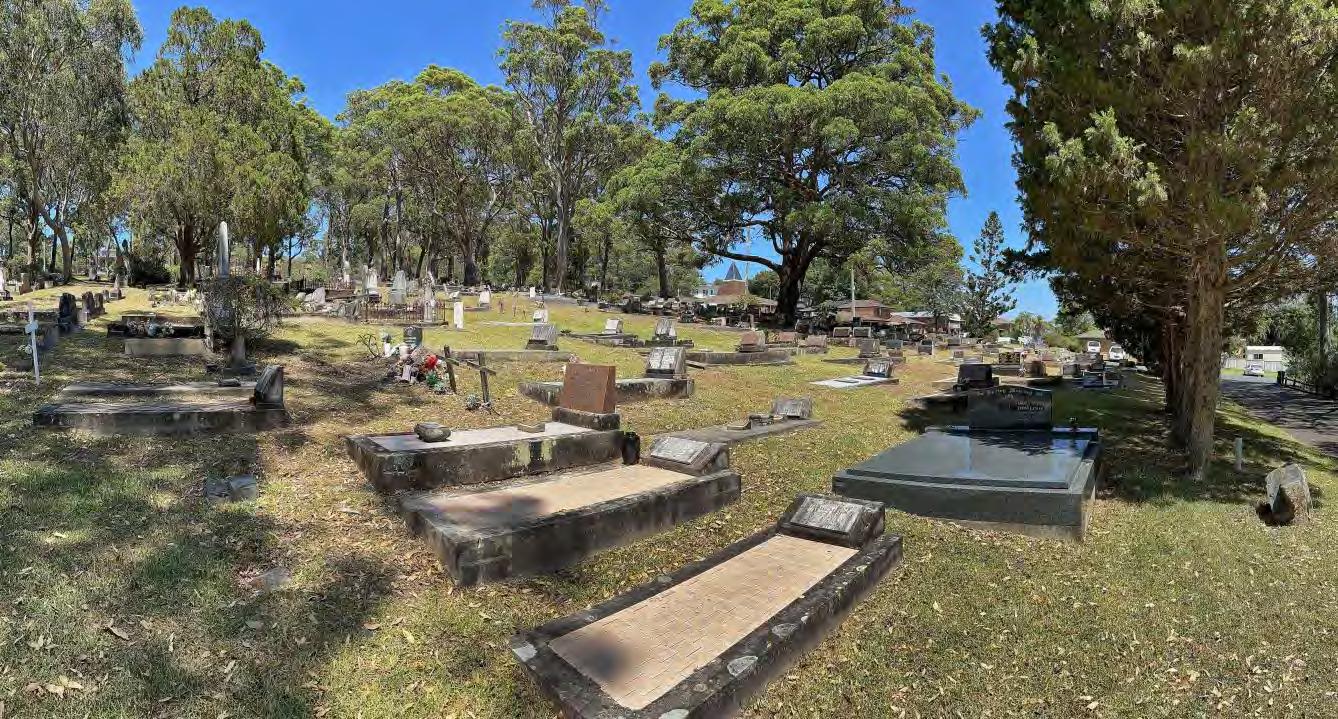
MidCoast Council Cemeteries Strategy Page 15
Forster Cemetery
5 Noting that consideration may also need to be given to consultation outcomes with Aboriginal groups with respect to their connection with this cemetery and any expansion opportunities, as part of Council’s obligations under Licence Condition E2.
• Dawson River Cemetery: Whilst not identified as having immediate capacity constraints by Council, the Dawson River Cemetery is the most highly utilised cemetery in the LGA for bodily burial. Combined with the lawn burial area in the western portion of the site becoming constrained (particularly noting flood levels), there is a need to establish a long-term plan for how the cemetery will continue to be used. Long-term options may include:
– Comprehensive development of the eastern end of the cemetery site where there is currently limited monumentation
– Infill development of southern portion, albeit potentially constrained by flooding
– Smaller infill area centrally within the site, where established trees may provide an attractive central area that could be combined with new memorialisation offerings – albeit being limited in size
– Expansion of the cemetery onto other lands
– Development of an alternative private cemetery, such as within the Brimbin township, albeit the timing or availability for interment is not currently known.
Plentiful space is generally available in other cemeteries given the extent of up-take that is being experienced. That said, some advance planning may still be advised to ensure long-term efficiencies in some key cemeteries such as Gloucester (southern portion) and to facilitate integrated lawn burial and memorialisation areas at Wingham.
Others require more immediate actions to ensure future development can proceed, such as obtaining relevant approvals for Tuncurry Cemetery, whilst Redbank Cemetery requires planning and consideration for space and cultural needs6 .
Recommendations
5 Establish and implement Master Plans for whole or relevant parts of Forster, Tea Gardens, Dawson River, Tuncurry, Gloucester, Wingham and Redbank Cemeteries, monitoring take-up of burial space to ensure that long-term plans are realised.
6 Pending the outcomes of master planning, consider other expansion options for Dawson River Cemetery if and as required.
Cultural and heritage management
Aboriginal cultural heritage
There is a strong connection between some existing Council cemeteries and the local Aboriginal community. This connection is particularly notable at:
• Forster Cemetery, where the Tobwabba spiritual art wall project and adjoining Aboriginal section are located,
• Redbank Cemetery, where large sections of the cemetery are associated with the local Purfleet Aboriginal community, and
Including
MidCoast Council Cemeteries Strategy Page 16
6
consideration of consultation outcomes with Aboriginal groups with respect to their connection with this cemetery and any expansion opportunities that may be available, as part of Council’s obligations under Licence Condition E2
• Purfleet Aboriginal burial grounds/cemetery, which is identified as being of high cultural significance to Aboriginal people of the area, though is not operated by Council
Consultation with First Nations people in the Forster, Taree and Gloucester areas identified a number of key issues of concern. These included:
• Concern about the cost of burial plots and the affordability for Aboriginal communities given their connection to the land, the socio-economic position of many Aboriginal people and their desire to conduct interments following their cultural beliefs,
• The extent of unmarked graves, and provision of infrastructure on, or misuse of areas believed to contain, unmarked graves,
• The sharing of data on grave sites, including the use of ground penetrating radar that can identify unmarked graves and information gathering to reduce gaps in data,
• Opportunities for expansion of Aboriginal burial sections / cemeteries at Redbank and Forster or the development of new / operational Aboriginal cemeteries (eg Tobwabba Hill or Purfleet Cemetery),
• A desire for cultural norms to be respected and enabled, such as graveside vigils, grave filling and the like, and
• A desire to improve the visual amenity, comfort and safety within cemetery areas through clean-up of burial sections, providing cost-effective alternatives to headstones (eg rock with plaque / inscription), headstone programs (eg TAFE programs), provision of memorialisation infrastructure (eg niche walls) to enable ashes interments and general infrastructure in the context of Redbank Cemetery in particular (eg roads, parking, drainage, toilets, seating).
Many of these issues and opportunities were seen to be inter-connected. Some can be resolved spatially through master planning or similar, some could be program-based activities (including community-based) on or off-site, whilst others were related to costs and opportunities to reduce or avoid costs through direct subsidy or alternatives to using Council’s cemeteries. Further detailed engagement and development of overarching directions for the implementation of any changes will be needed and will be required (in part) through Interment Industry Scheme conditions.
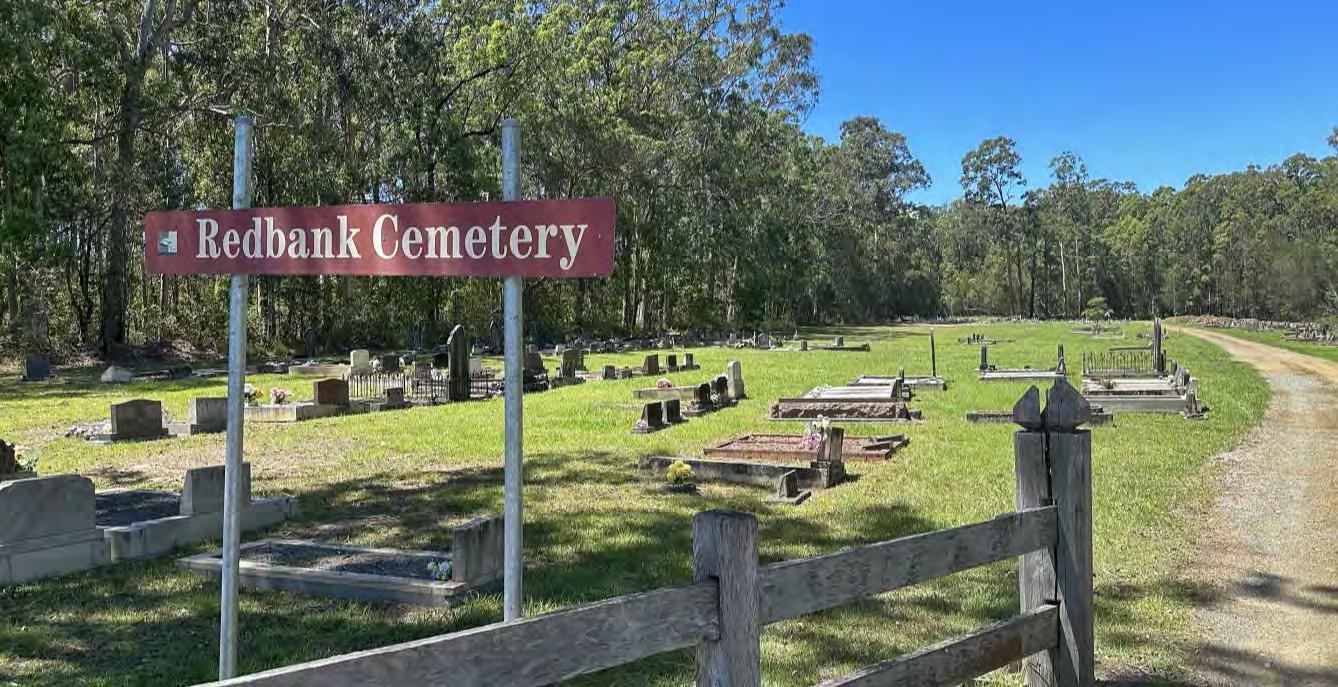
MidCoast Council Cemeteries Strategy Page 17
Redbank Cemetery
European heritage
Many of the cemeteries managed by Council are locally listed heritage items (or contain locally listed items). No cemeteries are listed as being of State heritage significance.
Cemeteries typically have a rich social history and are of heritage significance to past, present, and future generations. Whilst some cemeteries no longer provide for interments, many others continue to cater for community burial and memorialisation requirements. Whether continuing to be used for interments or not, cemeteries incur ongoing costs for maintenance and occasional improvements from an operational perspective.
Whenever changes are being considered for heritage listed cemeteries, it is important that such changes are made within a clear framework of the historical and heritage importance of the site. Whilst the heritage status and preservation of cemeteries needs to be recognised, consideration also needs to be given to the potential for those sites to continue to evolve to meet the needs of the community. In this way, cemeteries are part of the ongoing evolution of history of the area.
Works within cemeteries that create changes in use and visual amenity should consider management actions that may be in place such as Conservation Management Plans, Heritage Asset Management sheets and conservation works programs. Care of cemeteries with historical value is also recognised in a number of publications including the National Trust of NSW’s Guidelines for Cemetery Conservation (2009) that provides a community guide to the importance, identification and care for cemetery items.
In 2015, the former Great Lakes Council also prepared a Cemetery Management Plan for historic cemeteries including Willow Point Cemetery to assist in providing a framework for general heritage cemetery management, as well as specific heritage cemetery site advice for Willow Point. The document was designed for additional historical cemeteries to be included over time, though no further site-specific advice has been included to date. The document continues to provide important heritage objectives for Council’s cemeteries.
In response to the incorrect laying down of cemetery monuments by Council staff in July 2019, a Restoration Action Plan and Conservation Management Plan have also been developed to guide the future of The Bight Cemetery. The site-specific detail contained in these adopted documents should form the basis for ongoing management of that site.
Consultation for the Strategy also identified a preference from heritage related groups, and informally by Council’s Heritage Reference Group and the National Trust of Australia (NSW), that a review of listings be undertaken. This could include updating of existing listings, as well as consideration of additional listings where existing cemeteries are not currently listed as local heritage items. Alongside this review, these groups also identify the potential for an overarching Conservation Management Plan (or similar) be developed to guide conservation activities. Given the Cemetery Management Plan for historic cemeteries including Willow Point Cemetery already includes a number of cemeteries, such a review may be best delivered through a review and expansion, or incorporation of, that document.
It is important to note that:
• All cemeteries are intended to be retained and maintained consistent with their ongoing use as, or reservations for, cemetery purposes. While formalised listings may provide additional levels of protection or funding streams, there appears to be little risk that ongoing cemetery use will not continue, and that heritage listings may instead result in additional assessment requirements and processes that can add costs to future activities.
MidCoast Council Cemeteries Strategy Page 18
• Monument maintenance and care is the responsibility of the licence holder, not Council. Whilst heritage assessment may result in the identification of monument care or improvement recommendations, the permission of the licence holder would typically be required prior to undertaking any such works.
Recommendations
7 Establish and facilitate relationships between key Aboriginal groups and Council to continue to foster positive outcomes for the recognition of Aboriginal people within Council’s cemeteries.
8 Continue to consider heritage values of cemeteries within the context established by respective heritage listings, site specific heritage information, and the Cemetery Management Plan for historic cemeteries document
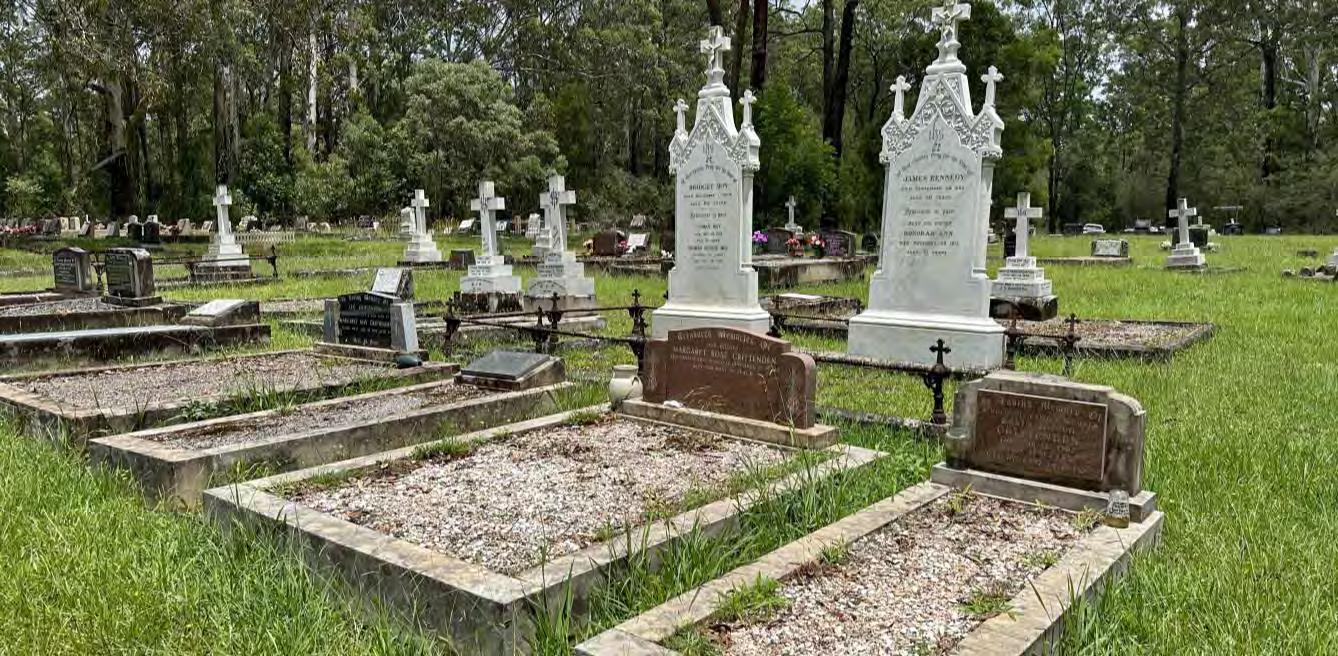
Strategy Page 19
MidCoast Council Cemeteries
Lansdowne Cemetery
Staffing for service provision
The operation of cemeteries under the three former councils, and now also as the amalgamated MidCoast Council, has been undertaken using a mix of in-house and contractor responsibilities. With cemeteries and memorialisation processes being very traditional and long-lasting, making changes to service provision to achieve consistency following amalgamation has been an ongoing process.
As of early 2023, there are four internal cemeteries administration staff that are responsible for operational matters – ie the administration of allocations of interment licences, reservations and the like. While there are some dedicated staff that undertake maintenance and interment activities at Council’s cemeteries, these are undertaken through a cost recovery model via Council’s parks and engineering sections. Additional assistance is also provided via contractors for maintenance services and where required, for grave digging.
Whilst dedicated care for cemeteries is an important long-term component of creating community connection, this mixed approach appears to be effective for Council’s geographically disbursed teams and comparatively vast number of cemetery locations. It is however noted that providing consistency in levels of service between teams is a key issue that needs to be addressed.
Within the context of cemetery administration, the introduction of the Interment Industry Scheme also has the potential to increase the extent of legislative oversight and reporting requirements associated with the service. Together with resourcing to improve online / digital records and a long-term increase in community connection through events (eg “death cafés” and “Dying to Know Day” activities), there may also be a need to increase internal resourcing. This would have a shortterm focus on digitisation of data to improve longer-term efficiencies, before moving towards implementation of licencing monitoring and community engagement.
The reality for Council is that the cost of operating the cemeteries is likely to increase in-line with community and regulatory expectations and having experienced staff to off-set these costs against an improved service may be critical to long-term success. These additional costs can either be worn by Council given recent improvement of financial performance, recouped through increases in fees and charges or by attracting (or reattracting) services
Should Council seek to establish a more focused direction, then improving memorialisation products and instituting more focused maintenance activities would be essential. Experienced and dedicated staffing resources are necessary to maximise this potential.
Recommendations
9 Consider ongoing need for additional internal (or temporary external) staffing to facilitate digitisation of records, administration of licencing requirements, and increasing community connection to Council’s cemetery offerings.
10 Consider ongoing need for training and up-skilling of cemetery team members through appropriate courses such as those provided by the Cemeteries & Crematoria Association of NSW. This includes customer service training for those at the public interface (including ground staff), as well as cemetery safety (refer to Recommendation 17)Error! Reference s ource not found.
MidCoast Council Cemeteries Strategy Page 20
Infrastructure, maintenance and facility provision
There are several considerations with respect to the physical infrastructure required to operate cemeteries. Many of these relate to ongoing maintenance and infrastructure provision to suit burial and memorialisation demands, whilst others relate to value adding to basic levels of service for customers or to meet other access and safety needs Importantly, cemeteries in the MidCoast area are offered in ‘perpetuity’, this means that there is a commitment to maintaining cemeteries long into the future.
Long term financial sustainability - Perpetual maintenance
A key consideration of CCNSW over many years is how to ensure ongoing financial sustainability of the cemeteries sector given the perpetual nature of interment. To enable this consideration, there is a need to estimate the long-term maintenance liabilities associated with the existing cemeteries and their future infrastructure needs as part of the process of identifying Council’s longterm funding requirements.
Once those liabilities are more clearly understood, along with short, medium and long-term capital works programs, the required level of ongoing funding can be calculated, and business planning and fee setting undertaken to establish long-term financial sustainability. This process is commonly referred to as planning for perpetual maintenance
While the new Interment Industry Scheme does not currently include perpetual maintenance requirements, CCNSW have identified that it is likely to become a focus of future stages of the Scheme.
Long-term capital works implementation and renewal
The long-term infrastructure requirements of Council’s cemeteries will need to be determined based on future assets identified by each site and more detailed master plans as these are developed over time. At present, capital works are undertaken primarily on a demand driven basis, including individual beams and walls or broader cemetery expansion, as well as asset replacement such as fencing and retaining walls.
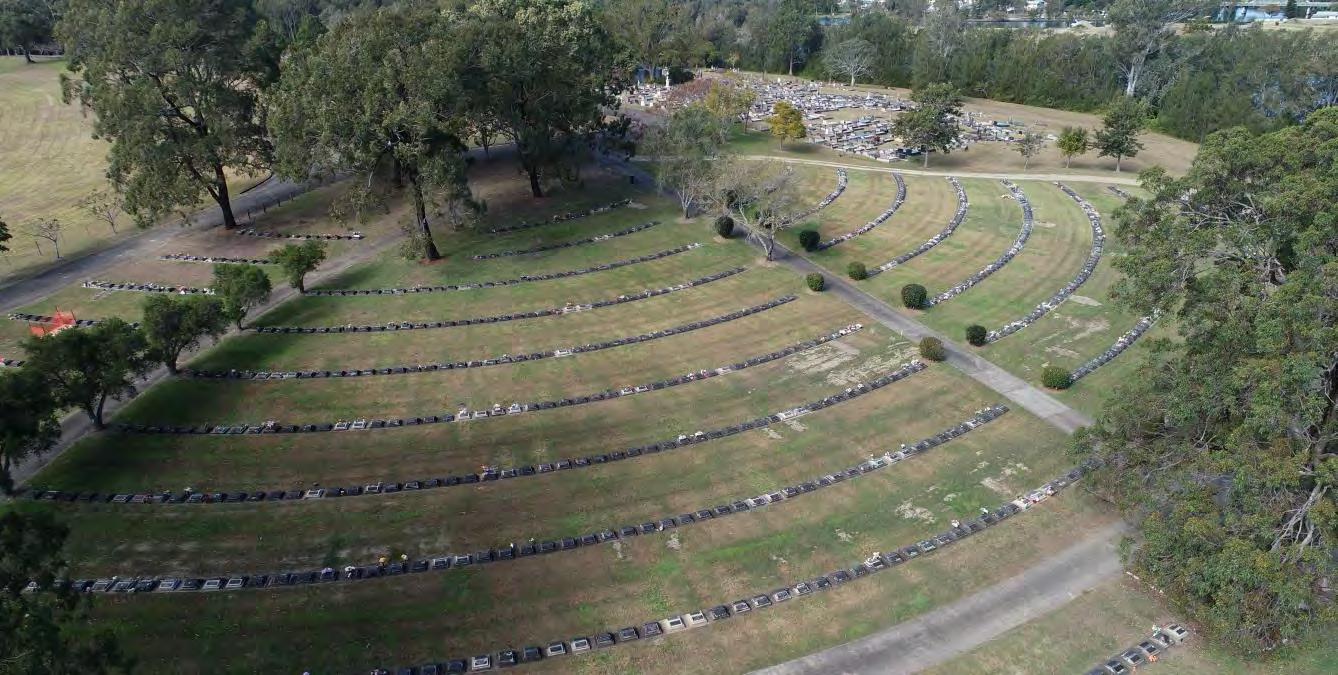
MidCoast Council Cemeteries Strategy Page 21
Dawson River Cemetery
Into the future, forward planning and more detailed cost allocation for future works would be recommended, including the more comprehensive capture of existing asset data condition and renewal needs. Ultimately this process is a balance between providing attractive and appropriately well-maintained sites with the long-term costs of implementation and replacement of assets at the end of their useful life. As such, the majority of future planning of assets should be concentrated in those areas and for those activities that are income producing or high use - such as combining memorial areas, lawn burials and access areas that are typically associated with high-use and need to be well maintained.
Capital works implementation should be planned into short to medium term programs (eg ten years) which establish the desired projects, undertakes detailed planning and ultimately allows for delivery. Whilst longer-term capital works may also be identified given the potential long lead times for some larger projects, these would obviously need to be regularly reviewed to meet the needs of the service at regular intervals - potentially as a revolving ten-year capital works plan.
Ongoing Costs
At the detailed level, a focus on operational and administration costs is important to inform longerterm understanding of expenses and the needs for pricing of services. At the current time, the use of a mixed model of regular in-house staffing and contractors for maintenance activities is supported and generally recognised as an effective long-term strategy to balance physical maintenance and understanding of care standards around monuments and interaction with the bereaved.
Over time, and as maintenance requirements become more closely aligned to use patterns, this model could be designed to provide broadacre (basic) services through external contract, and detailed grave maintenance through internal teams (or alternatively, as a social enterprise model). This will enable a more flexible approach to assist in transferring maintenance effort to high-use locations. Ensuring that the same staff attend to and obtain a greater understanding of the cemeteries (including training on how to deal with and interact with cemetery users) is important to longer-term consistency of cemetery maintenance.
Current liabilities
Based on the concept of gradual collection of perpetual maintenance funds, a cemetery operator could be expected to accrue substantial perpetual liability funds to assist in maintenance costs into perpetuity. According to the “Efficient costs of interment services”7 paper prepared for IPART in 2020, perpetual funds should preferably be accrued at around $1,000,000 per hectare, or around $800 per plot. This would in turn provide for a large portion of current maintenance and administration of these assets, as well as the many other opportunities identified for ongoing improvement.
However, a key consideration associated with establishing liabilities is the extent of legacy issues and their origins. For example, Council gained control of the majority of its Crown cemeteries in 1967 with no perpetual maintenance funding understood to have been provided at that time. Whilst the number of burial plots utilised within the cemeteries at this time is not readily available, a substantial portion of current perpetual maintenance shortfall should or could have arguably been provided as part of this transfer of responsibility. The remaining legacy gap would arguably have been addressed by Council over time, though it is not uncommon for this not to have occurred, and Council has arguably been funding the gap since 1967 in lieu of collecting this allocation. There remain key questions of how to fund this legacy gap in the future as recognised through the abovementioned report.
MidCoast Council Cemeteries Strategy Page 22
7 Deloitte Access Economics report for IPART - Efficient costs of interment services 2020
Recommendations
11 Pending the outcomes of Master Plans for cemeteries as previously identified (Recommendation 5), prepare a detailed ten-year capital works program to establish a list of expected capital works, including business case preparation and development of detailed implementation plans where required.
12 Consider options for a social enterprise provider to assist with cemetery maintenance, particularly where hand mowing and care around cemetery monuments is required.
13 Develop a plan, including advocacy to the State Government, regarding current perpetual maintenance liabilities.
Memorialisation
The relatively high and increasing cost of burial, combined with the increase in development and availability of crematorium facilities throughout the region, means that the option of cremation is becoming more attractive to many people. This change is reflected in the relative reduction in the number of burials and memorialisations occurring in Council cemeteries compared with the number of deaths in the LGA, which is estimated to have been close to around 30% in 2016/2017, compared with 25% in 2021/2022 – a relative reduction of more than 50 interments per annum. The provision of memorialisation opportunities that are integrated, attractive and present revenue potential for Council's cemeteries, is therefore important to the long-term use and financial sustainability. Based on broader industry statistics, the ash interment / memorialisation rate within cemeteries can be expected to be up to 20% - 40% of the total number of cremations8, though higher levels tend to be associated with facilities that have integrated funeral director, crematorium and cemetery facilities Even so, at around 10% at the current time, there are significant opportunities for growth in this area within Council’s cemeteries

MidCoast Council Cemeteries Strategy Page 23
Forster Cemetery
8 CCNSW identify around 1/3 of people have their ashes interred or scattered at a cemetery - See CCNSW Fact sheet 2: Understanding your choicesOptions for burial, cremation, funerals and ways to commemorate life
In particular, there are typically strong preferences from families to have a resting place that is associated with previous family interments. From this perspective, Council's cemeteries have a competitive advantage that mat be eroded if memorialisation facilities are not provided. If the public are aware of and are more readily able to access information on Council’s memorialisation products, there is much greater potential to attract memorialisation at Council’s cemeteries.
Memorialisation can be particularly important at localities where burial has, or has the potential to, reach capacity (for example at Tea Gardens and Forster), or where provision of alternatives to burial would be well received due to the size and scale of existing facilities (for example at Dawson River and Gloucester). In doing so, it is suggested that Council develop a “good, better, best” approach to memorialisation offerings such as the following:
• Good - such as a memorial only opportunity, such as a "butterfly tree" or “memorial boulder” style memorials, which do not incorporate provision of ash interment - though remaining possible for ashes to be scattered is an adjoining area within the cemetery (this in integrated into a number of existing walls and other facilities – particularly in the former Great Lakes Council area)
• Better - Niche or columbarium walls, potentially within a fixed, low maintenance area where future walls can be developed into a more substantial arrangement - ie avoiding a single oneoff placement where no logical expansion can be facilitated over time
• Best - Formal garden edge and / or fixed garden memorials within a higher maintenance area. These typically have greater ongoing maintenance costs, necessitating additional pricing.
A number of potential memorialisation examples are provided in Figure 1


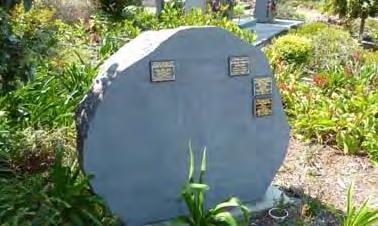

MidCoast Council Cemeteries Strategy Page 24
Memorial only "butterfly tree" (Wallsend)
Memorial boulder (Catherine Hill Bay)
Combine wall and garden (Lake Macquarie)
Formal garden edge memorials (Berry)
Figure 1: Memorialisation area examples
In addition to more substantial memorialisation opportunities in key cemeteries, opportunities for small memorial opportunities could also be explored in smaller cemeteries. This could include small scale memorial beams - an example of which is shown in Figure 2
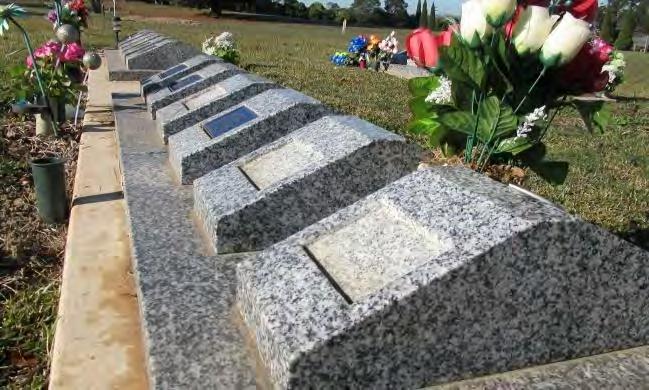

Recommendations
14 Provide new memorialisation options, consistent with forward planning proposals as identified in Recommendation 5, with a view to increasing revenue from memorials over the medium to longer-term.
15 Undertake a detailed examination of options for the introduction of low key, controlled memorialisation opportunities at smaller, low utilisation cemeteries
Monument consistency and safety
Safety concerns are typically present with respect to monuments within all cemeteries (and monuments elsewhere). Whilst the maintenance of monuments is generally not the responsibility of cemetery operators, the general safety of the grounds for users is of public concern and a risk to the operator. AS4204:2019 - Headstones and Cemetery Monuments provides a source of information for monument standards following the previous 1994 version. However, monuments prior to current standards (or that have not followed the standards), and particularly those prior to 1994, can present a significant challenge for many operators.
Maintenance and treatment of cemetery monuments should always be undertaken in accordance with applicable heritage legislation and suitable guidance, such as the National Trust of NSW Guidelines for Cemetery Conservation. A risk-based process for testing is also generally recommended, utilising guidance from verified industry sources.
In general terms, and subject to suitable professional risk assessor review, this may initially be based on those monuments that are most likely to be exposed to public interactions - for example those along public access roads and walkways - followed by staged review of others. For example, the former Rookwood General Cemetery Reserve Trust has previously advised that it undertakes testing on 20% of monuments each year, via a five-year rolling program. This type of program would be consistent with the Interment Industry Scheme Condition B.2, that includes “If there are memorials on the Site, outlines a monument safety inspection cycle that provides for an inspection of memorials at least once in every 5-year period”.
MidCoast Council Cemeteries Strategy Page 25
Images of Moss Vale Cemetery memorial beams
Figure 2: Memorial ashes beams
When developing a policy and/or program with respect to monumental safety, Council will need to consider both the commitments made to the community in association with The Bight Cemetery restoration, as well as the requirements of CCNSW’s Interment Industry Scheme conditions.
To avoid future issues in current monuments, it is important to have clear guidance on monumentation and processes in place to ensure appropriateness of the works undertaken. While all cemeteries have full monumental areas, the majority of burials take place in more controlled lawn cemetery sections. Council’s approach to monumentation in association with these areas is variable, as shown in Figure 3 below.

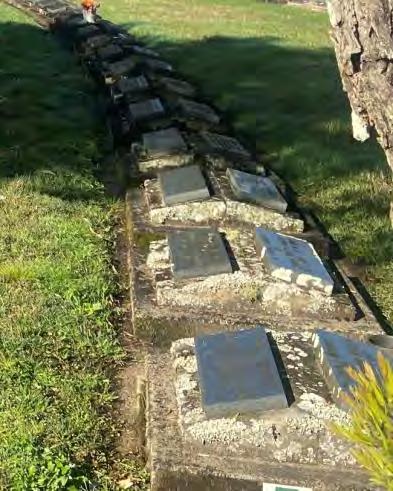
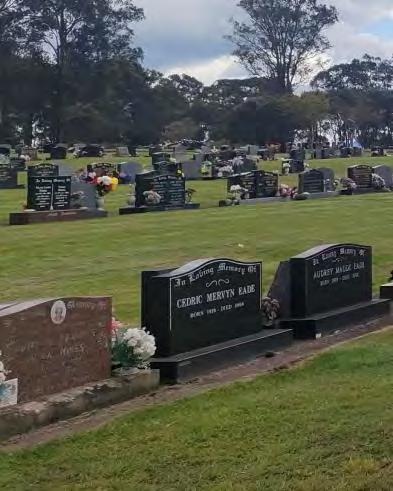
Within monumental areas, guidance is again important to ensure that freestanding monuments are of an appropriate size (eg not encroaching on adjoining sites), construction standard (ie meeting AS4204:2019) and consistency with the cemetery setting (eg colour and/or materiality). General cemetery requirements, combined with detailed direction provided by Australian Standards, are recommended to be developed.
Recommendations
16
17
18
Develop and implement a recurring monument safety review process, with guidance to be sought from appropriate experts, and in conjunction with CCNSW’s Interment Industry Scheme conditions, as well as existing Council commitments
Consider options for staff training, such as the Cemeteries & Crematoria Association of NSW “Cemetery Safety” training course, particularly for staff associated with grave digging and site maintenance activities
Develop monumentation construction guidance, eg “Monument Specifications”, to apply to all Council cemeteries to create both a desired level of consistency and assurances of safety into the future
Cemetery maintenance
A key difference between many local government and Crown or private operators is in the ongoing maintenance and presentation of respective cemeteries. It is recognised that the condition and presentation of facilities is an important aspect of customer satisfaction, as well as business development with respect to attracting greater take up of burial and memorialisation opportunities. It is also recognised that high levels of maintenance come at a cost, and a balanced approach to this is therefore necessary.
MidCoast Council Cemeteries Strategy Page 26
Tuncurry Cemetery Dawson River Cemetery Gloucester Cemetery
Figure 3: Lawn cemetery section monumentation
Cemetery grounds can generally be divided into three areas:
• High use / active - being areas that are regularly used for burial and memorialisation, such as current lawn cemetery areas
• Low use / transitional - being areas where there is irregular use, perhaps only by existing reservation or second burial for example
• Historical - where there are not typically any new burials that occur, and the cemeteries (or parts thereof) are maintained primarily for their heritage values (albeit an occasional and infrequent burial may still occur).
Correspondingly, the level of maintenance of these areas may also change. A contemporary view of maintenance requirements suggests that high use areas would have the greatest level of improvements and subsequent maintenance regimes. Based on the above, this would particularly include entries, main access roads, memorial areas and active burial zones. Low use areas (particularly in and around older monuments) may not have the same maintenance frequency, with pedestrian access tracks or vehicle tracks maintained more regularly than other areas, moving towards a more “historical” maintenance regime.
Examples of well maintained, but more natural areas, are highlighted in Figure 4



Improvements to infrastructure, including new memorial walls and gardens, can also be focused on these high-use areas, making the cemetery more appealing to most users, whilst balancing demands in other areas. To assist in this direction, site master plans are envisaged to focus on the use of access avenues and centralised locations (where greater maintenance effort may be expected) which are then accompanied by greater memorialisation opportunities - either near new expansion entry areas (such as at Gloucester) or being within the context of the movement network (such as the turning circle at Dawson River).
MidCoast Council Cemeteries Strategy Page 27
Burrawang Cemetery (Wingecarribee Shire)
Rookwood General Cemetery (Sydney)
Retained trees in lawn setting (Kemps Creek)
Figure 4: Natural maintenance regimes - sample images
The cemetery experience from a user perspective can also be improved, and savings can be made, across the longer term by the provision of assistance in:
• Identifying appropriate construction and plant species for minimal maintenance - for example drought resistant natives and robust raw materials such as sandstone, hardwood timber and concrete
• Creating a consistent and attractive palette of structures, signage and plantings - based off master planned materials palettes
Recommendations
19 Over time, develop a tiered cemetery maintenance regime that seeks to focus on core use areas in key cemeteries, with a view to formalising a tiered maintenance regime across all cemeteries.
20 Undertake annual site reviews with suitably qualified Council staff (ie horticultural staff), and with consideration of any subsequent master plan directions, to identify necessary changes in maintenance needs or future priorities
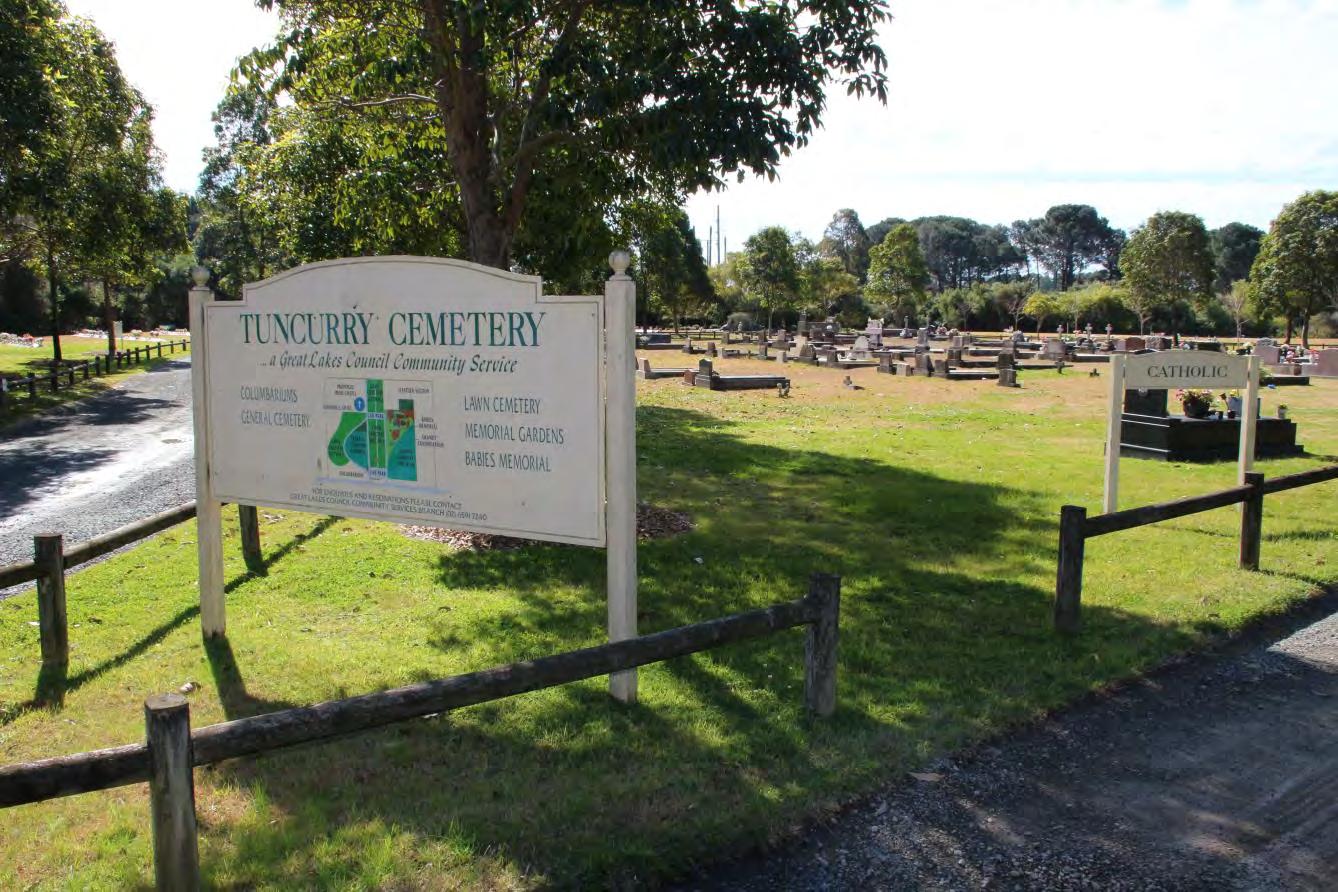
MidCoast Council Cemeteries Strategy Page 28
Tuncurry Cemetery
Service development
To ensure appropriate and sustainable provision of the service to continue to meet community needs, a number of opportunities exist for further consideration These opportunities are focused on initially gaining a stronger understanding of existing costs and revenues, and to then focus on creating consistent standards and further developing service opportunities in a more targeted way. This will primarily include identification of maintenance standards and processes, delivery and promotion of memorialisation options, creating a platform for monitoring and reporting on financial goals, as well as building a close connection with the community to encourage and facilitate long-term use of Council’s facilities. These directions are further discussed below.
Record keeping
As part of the process of understanding of supply and demand within Council’s cemeteries, it is acknowledged that accurate record keeping is required which can be readily used to make accurate assessments. At the current time, and while noting that Council now utilises some online systems, historical records and processes for site identification are largely manual.
Establishing an integrated online / cloud-based system will, over time, enable the consistent gathering of information, integration of layered mapping to accurately record availability of sites, as well as external access for family genealogy searches, funeral directors, and geographic referencing of specific grave sites. It can also include add-on opportunities such as historical information, cemetery trails, ‘find a grave’ real-time directions and the like Integrated burial records will also significantly assist and inform review and monitoring processes.
With respect to financial records, accurate data collection is important to ensure that the goal of becoming more financially sustainable over time (meeting service costs), and into perpetuity, can be realised. In particular, recording and monitoring financial outcomes will be needed so that pricing / fee increases can be considered as the service progresses into the future.
Overall financial performance over time, and particularly the contribution of funds to a cemetery reserve (as is likely to be eventually required as part of an Interment Industry Scheme), will determine whether the service is able to be sustainable over the long term and into perpetuity. As such it is important that progress be monitored as part of a standardised reporting process that integrates financial results alongside burial, reservation and memorial take-up.
Recommendations
21 Review the capture of service costs and revenues to ensure accurate financial records are being kept, including the correct allocation of all revenues according to advertised fees and charges
22 Include a range of financial indicators relating to revenues and expenses incurred by the service within an annual or bi-annual management reporting cycle so that revenues and expenses can be aligned to the extent of use / demand (up-take of burial, memorial and reservations) over repeat periods
23 Undertake a review of cemetery management software with a view to enabling cemetery mapping, public access and online bookings to be facilitated whilst enabling consistent and accurate record keeping / reporting.
MidCoast Council Cemeteries Strategy Page 29
Community connection to Council’s cemeteries
Given the spread of cemeteries within the MidCoast area, there is likely to be a high level of community trust associated with the service, as also evidenced through consultation outcomes. Inturn, the service relies on this community trust to translate into use of Council’s cemetery sites. Continuing to build community trust and relationships is therefore an important aspect of future growth. Connecting the community to Council’s cemetery sites through an emotional bond increases recognition of the service within the general community and can be achieved in subtle and positive ways through a range of activities and events such as:
• ‘Death cafes’ and ‘Dying to Know Day’ events
• Consideration of a ‘friends of the cemetery’ type group/s
• Information sessions for local community groups and organisations.
‘Friends of the cemetery’ groups are present in many parts of Australia and around the world. These groups are typically volunteer based groups, often made up of members of historical societies or general community members Groups work with cemetery managers on specific projects and maintenance tasks that assist in the long-term care and beautification of cemeteries (eg the recent commencement of the Lismore Memorial Garden’s friends’ group)
Groups may also assist in requests for genealogical information, an aspect of cemetery services that can be labour intensive and often not an immediate priority for cemetery managers.
As identified earlier, there may also be benefits to other forms of positive community interaction, such as engaging a social enterprise for some detailed maintenance tasks around monuments, as successfully utilised in the Wingecarribee Shire for example.
Recommendations
24 Identify opportunities to increase the connection between Council’s cemeteries and the community through events and site activities, as well as potential for volunteer programs such as a formalised ‘friends of the cemetery’ group

Cemeteries Strategy Page 30
MidCoast Council
Harrington Pilot Hill Historic Settlers Cemetery
Marketing and technology
Given the increasing levels of cremation across regional areas, and combined with the small market share of the memorialisation market currently held by Council, there is significant opportunity to broaden the scope of services from a burial focus to a more mixed burial / memorialisation model that better responds to community needs.
In the short-term, the business development focus should be on ensuring that the existing and any new stock of available memorialisation options is well represented on Council’s website and through fixed marketing collateral such as brochures. This requires professional photography and brochure production that includes details of the facilities and, where possible, associated pricing. Separate content for Council’s burial options could also be developed.
In addition to the use of fixed and web-based information, there is also opportunity to create efficiencies for customers through the provision of more accessible information. Primarily, this relates to web-based access to clear, attractive and easily understood information that enables users to speak with their funeral directors or Council, review options on-line or at the site utilising information or directions on-line, and to enable people to compare Council's cemeteries to others.
Whilst it is recognised and agreed that online information will not replace the need for face-to-face services to some customers, it is a relatively low cost, measurable and effective way to reach those that may not have time to meet with Council during business hours or who simply want to compare the offering that they may have received from others.
Recommendations
25 Prepare both online and hard copy content which highlights key product offerings, their cost and availability, for publication on Council’s website and for distribution to Funeral Directors

MidCoast Council Cemeteries Strategy Page 31
Oxley Island Cemetery
Natural burial
Increasing recognition of environmental impacts of human interactions continues to grow and is increasingly relevant to the death care industry. Requests for natural burial and improved environmental outcomes was also a common theme in consultation for this Strategy. For cemeteries, ‘natural burial’ opportunities are regularly identified as a future trend. This is a form of burial process whereby, in its purest form, the body is returned to the earth in a natural state and the burial site is also returned to its natural state with no on-site memorial or marking. This form of burial has been growing in popularity for some time, particularly in the United Kingdom where it was first used under the term woodland burial. Further growth in this form of burial is expected as more environmentally aware generations reach older ages.
A number of natural burial areas have been established in NSW, including the Sydney Natural Burial Park (Kemps Creek) and the Bushland Cemetery at Lismore Both these facilities are based on the presence of environmentally sensitive land being located on an existing cemetery site, with natural burial being identified as a way to balance use of the respective sites with ongoing retention and restoration of the associated vegetation Take-up of natural burial has however been relatively low, with some identifying that the lack of memorialisation associated with ‘pure’ natural burial being a significant deterrent from take up and that some form of memorialisation remains important to most families.
While there has been limited take up of this type of burial to date, it is still considered appropriate that allowances for the concept be made within one or more of Council’s cemeteries. This may be where there is either an existing bushland setting, or where bush regeneration can form part of future planning (eg tree planting accompanies each burial). Prior to full natural burial being offered, it may be appropriate that a ‘hybrid natural burial’ concept be investigated that provides for minimal intervention, but does result in some minimal form of on-site memorialisation and access pathways so as to provide a tangible link to the grave site – eg ‘bushland burial’ rather than ‘natural burial’. These same principles can also be applied to memorialisation, such as the memorial bushwalk concepts provided in Figure 5
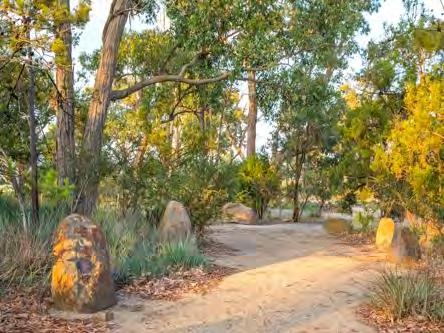
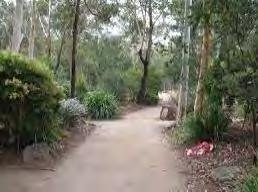
Recommendations
26 Investigate land and delivery options for natural burial within one or more of Council’s cemeteries
MidCoast Council Cemeteries Strategy Page 32
Ballarat Cemeteries
Shoalhaven Memorial Gardens
Figure 5: Bushwalk memorial examples
External trends
External trends are identified here to better understand the risks or opportunities to service provision by Council. While external trends cannot necessarily be controlled, actions can be put in place to guard against potential future impacts or harness future benefits
The purpose of this section is to therefore identify risks / opportunities and to outline appropriate actions that can be utilised to assist in ‘future proofing’ Council’s services wherever possible
Legislative change
Operation of cemeteries is regulated by a range of legislation, most significantly by the Cemeteries and Crematoria Act 2013 (C&C Act). The C&C Act was passed in November 2013, with the majority of the Act coming into force on 1 November 2014. The remainder of the C&C Act commenced in stages, with Part 4 commencing in June 2018. This Part of the Act is of particular note as it establishes a new system of interment rights, including regulating "renewable tenure" and setting out the conditions for re-use of interment sites (noting that renewable tenure is voluntary but not currently utilised within Council’s cemeteries).
The commencement of Part 4 also triggered a review of industry pricing by IPART that was completed in late 2020 The C&C Act also provided for a five-year statutory review which was broadened in 2019 to address other critical challenges facing the sector including land shortage (in Sydney) and associated cost implications. This review was finalised in August 2020.
As a result of both reviews, there is an increasing move by CCNSW to play a greater role in regulating the industry. This has seen the introduction in October 2022 of an Interment Industry Scheme which will licence cemetery operators for the first time in NSW. This means that there will be certain conditions of operating, with MidCoast Council being defined as a large operator with an average of more than 100 interments per annum
Moving forward it will be critical that Council’s operations continue to align with industry regulation. Information available at the time of preparing this report identifies a series of licence requirements under five key areas as follows9:
• Consumer contracts – standard terms and conditions explained clearly so customers can understand what they are paying for
• Cemetery maintenance – to make sure there are clear minimum standards for every cemetery
• Pricing transparency – so customers know what they are purchasing and can easily compare prices
• Customer service – to ensure operators are consistently providing quality service
• Religious, cultural and spiritual principles – to ensure respect for religious and cultural requirements and promote understanding of the unique importance of Sorry Business to Aboriginal people.
9 See https://www.industry.nsw.gov.au/cemeteries-crematoria/interment-industry-scheme (accessed 29 August 2023)
MidCoast Council Cemeteries Strategy Page 33
CCNSW have identified that the interment scheme will be accompanied by a series of guides and templates to ensure that operators are able to meet new requirements in a consistent way. Full compliance with licence conditions is required by October 2024 Council should continue to monitor scheme guidance as it becomes available (information provision is being staged) This will also be an opportune time to review current policies, forms and processes to align with new industry standards as they are finalised and as the licencing requirements become known.
It is more generally recommended that Council develop and formalise cemetery “Operating Guidelines” and “Maintenance Guideline” documents. These would provide both public and internal operating procedures upon which all policies, forms and procedures would be undertaken. These should be designed to clearly articulate the rules and processes associated with Council's cemeteries, building on Council’s existing information and including consideration of the above Interment Industry Scheme details as they become known.
Recommendations
27 Monitor changing legislative requirements, particularly the introduction of the Interment Industry Scheme, including associated guidance as these become available.
28 Utilising advisory guidance and templates produced by CCNSW (State Government) and CCANSW (cemeteries peak body) where available, Council review existing forms, processes and guidance to establish consistent information based on ‘Operating Guidelines’ and ‘Maintenance Guidelines’ documents and in accordance with industry standards
Industry expansion and competition
Council is in the fortunate position where their existing cemetery facilities are part of the fabric of respective localities and often in areas close to existing markets that cannot be readily replicated by the new market entrants. This means that there is relatively little ‘competition’ in terms of burial demand.
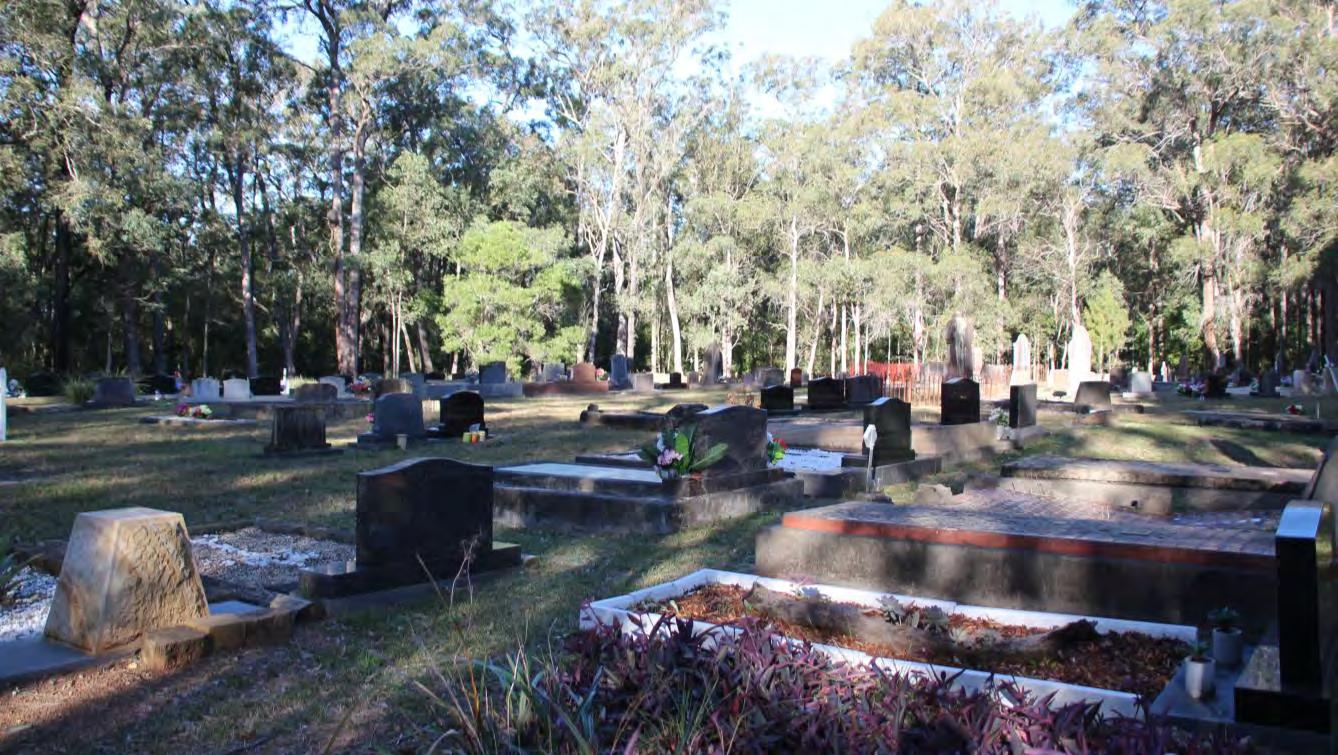
Strategy Page 34
MidCoast
Council Cemeteries
Failford Cemetery
However, in more recent years there has been a significant increase in the presence of privately owned regional cemeteries and crematoria - with two private cemeteries and crematoria already being present in, or located nearby to, the MidCoast Council area Whilst this does not present a major change to Council’s role in the industry in general terms, it does have the potential to reduce demand on Council’s cemeteries if there is not a strong connection between them and the community.
From this perspective, it is considered appropriate that Council take an attentive approach to create greater connection between Council’s cemeteries and the local community
Recommendations
29 Monitor industry changes whilst taking a more attentive approach to working with local industry participants, including greater connection to customers where possible and practical.
Refer also to Recommendation Error! Reference source not found. relating to strengthening the c onnection between cemeteries and the local community
New technologies and changing practices
Over and above the external trends in legislative and physical land / infrastructure requirements, there are also potential emerging industry trends with respect to the way that the deceased are disposed or interred. For example, trends towards more ‘sustainable’ forms of burial and cremation have been recently highlighted in relatively new technologies within the industry. Over and above natural burial processes discussed earlier, there have also been attempts to introduce new technologies to replace the more traditional cremation process that claim to reduce energy use (carbon emissions) and avoid the release of pollutants into the atmosphere.
Two such technologies include the “alkaline hydrolysis” and “crymotation” (or otherwise known as “Promession”) processes10. Alkaline hydrolysis involves the breakdown of the body through a pressurised mixture of water and lye (a corrosive alkaline substance) at a high temperature. The body is essentially broken down into its chemical components and results in a liquid material and bone remains that are easily crushed to an ash which can then be used in a similar way to cremated remains. Crymotation or Promession is essentially a method of disposing of human remains by way of freeze drying. The process is understood to use liquid nitrogen followed by vibration to reduce the body remains to a fine dust. Liquids are evaporated and metals removed prior to the burial of the remains in a small casket.
Within respect to bodily burial, creating greater efficiency in the use of land has also been more recently pursued in some areas. In locations that have greater burial costs and land shortages, there have been efforts to create larger and higher crypt or mausoleum style intermentssometimes being large multistorey buildings. While this is unlikely to be feasible in regional areas, there are other cost-effective opportunities such as the use of vertical burial techniques that can accommodate three burials in a similar space that would traditionally only accommodate one (or two where second interments are allowed)11 This process may also enable infill of areas that may otherwise not be of sufficient size to enable traditional burial
10 Refer to https://en.wikipedia.org/wiki/Alkaline_hydrolysis_(body_disposal) and https://en.wikipedia.org/wiki/Promession 11 See https://uprightburials.com.au/#whattoexpect for example
MidCoast Council Cemeteries Strategy Page 35
While these technologies may indeed be beneficial, the reality is that the acceptance of change in the funeral industry is also traditionally a very slow process and the take-up of any of these technologies or processes may take some time.
Recommendations
30 Recognise and monitor changing industry trends and technologies over the long-term, including consideration of their implications for Council’s cemeteries and services

MidCoast Council Cemeteries Strategy Page 36
Tinonee Cemetery
Conclusions
This Strategy has sought to identify the current, emerging and future needs for cemeteries under Council’s operational responsibility Recognising the large number and significant ongoing maintenance cost of cemeteries managed by Council, the long-term directions have been identified as needing to achieve two key elements:
• Maximising the use and efficiency of existing facilities through consistent application of processes to ensure their operational longevity, including for both burial and memorialisation purposes, and
• Creating efficient and effective administration processes to enable an increase in the delivery of community connections through information availability, marketing and product delivery that responds to community needs.
In respect of the existing facilities and their short to medium term use, the future of the cemeteries will see high use facilities being in a position to maximise burial space and make allowances for memorialisation options that observe a ‘good, better, best’ model. For the higher use cemeteries such as Dawson River, Wingham and Gloucester, this may require the upgrade of existing or development of new memorialisation interment areas, as well as review of lawn burial areas across all cemeteries (except Forster Cemetery).
In general terms, these directions will enable Council to:
• Maximise capacity (and therefore the life span) of the cemeteries for burial activities, taking into consideration the constraints and opportunities of the respective cemeteries,
• Ensure localised opportunities for memorialisation long into the future, reflecting both burial capacity restrictions in some localities, as well as community preferences and high cremation rates, and
• Facilitate logical and targeted asset delivery and ongoing maintenance efficiencies over the long-term.
In conjunction with these key high use cemeteries, Council will also ensure the ongoing availability of its smaller and lower-use cemeteries, including consideration of smaller scale memorialisation opportunities to supplement ongoing burial use activities at these cemeteries to assist in creating a diverse spread of options for future use
From an administrative perspective, and alongside the physical delivery of cemetery spaces, there is a recognised need to create consistency in the delivery of a range of processes and procedures. Key aspects include:
• Provision of a ‘Cemetery Management Guideline’ that outlines the range of processes and procedures that are associated with the delivery of interments at Council’s cemeteries,
• Provision of a ‘Cemetery Maintenance Guideline’ that outlines the internal maintenance processes that apply to Council’s cemeteries, and
• Provision of a ‘Cemetery Policy’ that outlines key policy decisions taken by Council in response to identified needs
Together, these documents will provide both internal and external facing information that ensures equitable delivery of service standards across MidCoast cemeteries, and consistent with recent changes to bring pricing into alignment. They will also provide clearer delineation of cemetery staffing responsibilities and enable Council management to create ongoing review and adjustment of resources needed, and pricing of services to create the desired level of sustainability.
MidCoast Council Cemeteries Strategy Page 37
Underlying the documentation of operational needs will be a concerted effort to update and implement a modern interment register. This will ensure operational efficiencies in administration, clearer and more accurate information for the broader industry (eg funeral directors), as well as enabling public access to information for a range of genealogy / heritage / historical information and provision of onsite information that enables cemetery plots to be readily accessed.

MidCoast Council Cemeteries Strategy Page 38
Mitchells Island Cemetery
Appendix B: Cemetery facility directions
This appendix provides a summary of the proposed future directions identified in the development of this Strategy for specific active cemeteries where interments are still available Historic or inactive cemeteries are to be maintained consistent with the Cemetery Management Plan for Historic Cemeteries including Willow Point Cemetery (2015).
General cemetery facility provision
Based on review of CCNSW publication Voluntary code of practice for cemetery maintenance (February 2020) and Interment Industry Scheme licencing conditions, the following facilities and infrastructure should be considered at all cemeteries:
• Safe access points for people and/or vehicles that are easily identifiable
• Suitable entry, active use area, or broader cemetery fencing and signage commensurate to the setting and scale of use
• Suitable signage to enable visitors to orientate and locate areas, such as inclusion of cemetery mapping (potentially in association with entry signage), section and row signage and/or access to online mapping
• Cemetery signage to include cemetery name, Council’s contact details and opening hours (in accordance with licencing condition B.5)
• An asset audit be undertaken at all cemeteries to establish all current assets, condition, and replacement / upgrade priorities based on existing situation.
As far as practicable, design standards should meet AS 1428 (Parts 1-5): Design for access and mobility for future works and where major renewal occurs.
High use active cemeteries
Dawson River Cemetery
• Establish a long-term master plan for the site to accurately establish the extent of available land, expected life and potential need for changes in policy
• In conjunction with above master plan, establish directions to reinvigorate or establish new memorialisation areas to ensure effective delivery of associated products
• Pending outcomes of master planning process, and where expected life is below 20-50 years, consider options for cemetery expansion or identification of new site to service the area
Tuncurry Cemetery
• Establish currency of master plan and associated development approvals
• If approvals have not been sought or modification of approvals is not problematic, consider review of master plan to establish more efficient use of land (including lawn cemetery configuration) given limited size of cemetery and long-term needs
MidCoast Council Cemeteries Strategy Page 48
Forster Cemetery
• Review northern portion of cemetery to determine permissibility of use for interment (noting land is Council managed Crown land with a public purpose of ‘plantation’), and eastern portion (extending along Likely Street) of the cemetery to determine the potential to expand the Aboriginal portion of the cemetery into the currently vegetated area
• Pending outcomes of above, establish a master plan for:
• the long-term implementation of memorialisation offerings
• potential cemetery expansion noting the limited size of the site and availability of burial plots
• recognition of Aboriginal burial areas and unmarked burials, including data capture of burials based on detailed discussions with heritage and Aboriginal groups (design and extent to be confirmed with local Aboriginal community engagement through detailed process and use of ground penetrating radar)
• provision of seating and potential shelter or memorial areas to recognise and commemorate unmarked graves / known burials that cannot be identified
Gloucester Cemetery
• Establish a long-term master plan for the southern portion of the site to accurately establish the long-term infrastructure needs, costs and capacity (including establishment of dedicated memorialisation area)
Wingham Cemetery
• Establish a long-term master plan for the north or north-eastern portion of the site to accurately establish long-term infrastructure needs, costs and capacity. Area to include existing lawn burial area, integrated memorialisation opportunities, rectification of potential neighbouring encroachment and clarification of access arrangements.
• Within the context of broader natural burial review, consider potential opportunity for natural burial area in the north-western corner of the site
Low use active cemeteries
Bo Bo Creek Cemetery
• Consider the establishment of low-level niche beam or similar low scale option within the cemetery
Bulahdelah Cemetery
• Consider option for the expansion of existing memorialisation facilities, lawn cemetery area (with more efficient beam size) and access arrangements
Bulga Plateau Cemetery
• Consider the establishment of low-level niche beam or similar low scale option within the cemetery
• Within the context of broader natural burial review, consider potential opportunity for natural burial area within the site
MidCoast Council Cemeteries Strategy Page 49
Coolongolook Cemetery
• Consider the establishment of new memorialisation options, for example memorial wall/s within the cemetery
• Within the context of broader natural burial review, consider potential opportunity for natural burial area in the western portion of the site
Coopernook Cemetery
• Consider the establishment of a low-level niche beam or similar low scale option within the cemetery
Failford Cemetery
• Consider the establishment of new memorialisation options, for example memorial wall/s within the cemetery
• Consider potential for lawn beam arrangement and integrated memorialisation opportunities within the south-eastern portion of the site
Killabakh Cemetery
• Consider the establishment of new or expended memorialisation options, for example additional memorial wall/s close to the cemetery entry given the existing facilities are considered to be nearing capacity
Krambach Cemetery
• Consider the establishment of low-level niche beam or similar low scale option within the cemetery given the age of existing memorialisation wall
Lansdowne Cemetery
• Consider the establishment of new memorialisation options, for example memorial wall/s, potentially along the site access road / entry area
Marlee Cemetery
• Consider the establishment of new memorialisation options, for example memorial wall/s, potentially at the site entry area
Mitchells Island Cemetery
• Consider the establishment of low-level niche beam or similar low scale option within the cemetery
Moorland Cemetery
• Consider the establishment of an additional memorialisation option, for example new memorial wall/s, potentially at the site entry or along the site entry road
Oxley Island Cemetery
• Consider the establishment of low-level niche beam or similar low scale option within the cemetery
MidCoast Council Cemeteries Strategy Page 50
Redbank Cemetery
• Establish a master plan for the site to accurately establish the extent of available land, expected life and potential need for changes in policy and/or expansion of the cemetery Master plan to include:
• recognition of Aboriginal burial areas and unmarked burials, including data capture of burials based on detailed discussions with heritage and Aboriginal groups (design and extent to be confirmed with local Aboriginal community engagement through detailed process and use of ground penetrating radar)
• access road upgrade, turnaround area and car parking
• provision of seating and potential shelter or memorial areas to recognise and commemorate unmarked graves / known burials that cannot be identified
• opportunities for memorialisation facilities
• potential lawn cemetery area if suitable areas are available
• improvements to the road frontage including signage and landscaping
• Potential for future expansion opportunities
Stratford Cemetery
• Consider the establishment of low-level niche beam or similar low scale option within the cemetery
• Within the context of broader natural burial review, consider potential opportunity for natural burial area, via reforestation, in the eastern portion of the site
Stroud Cemetery
• Consider the renewal and upgrade of existing walls and associated facilities (eg landscaping) within the cemetery
Tea Gardens Cemetery
• Establish a master plan for the site to accurately establish the extent of available land, expected life and potential need for changes in policy. Master plan to include long-term opportunities for memorialisation facilities
The Bight Cemetery
• All future works to be consistent with site Conservation Management Plan, Management Plan, Restoration Action Plan and Landscape Plan once developed
Tinonee Cemetery
• Consider the renewal and duplication of existing walls and associated facilities (including landscaping) within the cemetery
Woola Cemetery
• No changes were identified due to the low demand experienced at the cemetery
MidCoast Council Cemeteries Strategy Page 51


